13 Popular Trailerable Sailboats with Lifting Keels
Sailboats are awesome, but they do come with their drawbacks. Storage and transport, for one, tends to be a demanding matter, which excludes their owners from many ways of sailing - you are unlikely to store one in your garage and drive it anywhere you please on the weekends, so finding a long term berth and sailing in the near vicinity is what most do. Luckily, there are models designed with precisely this issue in mind - so without further ado, here are 13 sailboats that you can easily put on a trailer and drive to a body of water of your choice.

13 popular sailboats with lifting keels that can be trailered
Beneteau first 18, catalina 22 sport, yacht yard focus 750, norseboat 21, bayraider 20, parker 235 mini cruiser, alubat ovni 365, gunfleet 43, franck roy solenn 27, maree haute django 670.
Now some of these are better at transport than others and some had to sacrifice space or performance for mobility. Let's have a look at them in detail so that you know which one fits your needs the best.
This one has to make the list because it is immensely popular. Rightfully so. It is small enough to be transported on a trailer, plus it has a lifting keel that makes the draft only 30 centimeters when up - but over a meter when down, so it still has to say a lot in terms of performance.
It has a spacious, open cockpit for six people and a v berth in case you want to spend the night. It is then not just a daysailer, but a weekend cruiser.
And if it is too large for you, it even has smaller brothers, Hunter 15 and 18. Those won't let you sleep under a roof, but their dinghy-like character makes them even more mobile.
I can't not mention a European brand - Beneteaus are made in all shapes and sizes, but this time, let's give a shoutout to their First 18, a tiny daysailer. It looks spectacular and has a significantly sportier character than the above Hunter - and even at 18 feet, it will let you sleep inside.
Just as is the case with the Hunter, First comes in more sizes - 14, 22, and 27 feet.
Make no mistake, this is not a boat to chill on. You can, technically, but its racing pedigree won't let you.
And thanks to its retractable keel, it is easy to pop out of the water and take back to your garage where you can admire its prettiness until the next time.
Before we get into more unknown brands, let's get this one out of the way - also an incredibly popular model, that is, if you are in the USA.
With the board down, its draft goes all the way to 1.5 meters and retracted, up to 0.5. You can trailer it easily, but at the same time it sleeps four people, so it isn't just a one-day pleasure craft.
A nice thing about Catalina 22 is that the model has around five decades of existence behind it, constantly improving on its design. So you won't be getting into experimental waters, so to say. It is a bit conservative conceptually, but that is the price to pay for being on something that knows what it's doing - as it has been doing it for more than half a century.
Now here is something you have probably never heard of if you are from the USA. A polish brand, established by former sailboat racers - and it shows.
For those unfamiliar with European geography, Poland borders the mighty Baltic Sea - so just as Scandinavian boats, their projects are properly seaworthy.
The N Fun 30 is a trailerable, lifting keel little vessel, in fact, the only model the company makes, but it is unlike any other boat in its class.
It looks gorgeous, has a racing pedigree, comes with a teak deck option (though it's not really teak, just a lookalike) which is so rare in the day sailing racers' class, and most importantly, is configurable to your liking.
Fully specced, this boat costs nearly $180,000. Yes, that. But if you can do without all the extras and are looking for something relatively traditional, it can be yours for $70,000. Even for this lowest configuration, you will still be getting one hell of a racer.
Another Polish project - that's why the numbers here mean meters, not feet. This approximately 24 ft long boat gets in and out of the water easily and is similar to the above N Fun in its good looks and racing character.
It is a forgiving single-handed sailor but can accommodate up to four people both on and under the deck. Just as the N Fun, it comes with an optional 50 square meters gennaker.
This boat is modern both in terms of design and materials used. Multi-directional fiberglass with a foam core, spacious, light interior design - quite a contrast to projects like Catalina. Its aim is modernity and it does it well.
Back into more familiar territories. Norseboats are known for their rugged, bluewater designs. They can survive pretty much anything since they are made to withstand the North Sea formerly populated by Vikings and the Kraken.
Trailering is a breeze, as the keel can be taken out almost completely, it looks beautiful, especially if you get the all-wooden version, new, it costs around $35,000 and it was made with performance in mind.
What sets it apart from the rest is its seaworthy nature. You can take it across oceans if you choose so. Then there are the old-fashioned, rugged looks. This boat is serious about its abilities and it shows.
On the water, you will be envied by vessels much larger than yours.
This one's a project from Swallow Yachts, a company that focuses on a classic look with modern performance. Not my words, this is their tagline. But it is more than just a marketing gimmick.
An interesting feature with the BayRaider is its water ballast, giving you a choice between greater righting ability and lightness, thus speed. The company also offers a 17 ft version as well as a 23 ft one - all of which feature a lifting keel, making the trailerability uncompromised.
The aforementioned performance part is taken seriously here. All foils have been calculated and constructed so that their shape helps with windward performance. In other words, the rudder and centerboard aren't just flat - their cross sections resemble those of airplane wings. That's racing boat territory.
The draft variability is also quite unique. Board up gets you to some 8 inches, the smallest here yet, board down gets you all the way to 4 ft 4 inches - something rather rare with a boat this size.
On the surface, this is just your normal, well-built, nicely designed trailerable family weekend cruiser. What differentiates it from, say, the above Hunter 22, is its interior.
Trailerable boats often have to compromise on space, but on this Parker, you will find enough space to sleep four, plenty of storage, and even a sink.
So if you wanted to cross an ocean on this boat with two people, you'd have enough space for all the equipment and crew. As well as a boat actually capable of such a crossing.
It is a vessel made well, it is sturdy enough for choppy waters and stiff enough to handle well in trickier conditions, all the while staying in the reasonably priced, small boat range.
As I like to stretch limits, let's touch the length ceiling. This aluminum boat has everything you would expect from its size. Two cabins, salon, galley, heads, captain's corner… simply a nearly 40 ft cruiser. And a comfortable one at that.
But a trailerable one. Lift the keel up and you can put it on a trailer. You'll need a larger one, and a car capable of towing around 10 tonnes, but all that is still within an easily reachable range.
With a boat this size, you can expect versatility. Long crossings, weekend cruises, all that is possible. It performs very well, looks stylish, and the aluminum gives you extra sturdiness.
Lifting the centerboard up will give you a draught of 2.5 ft, putting it down results in nearly 8 ft. The total sail area with a spinnaker is 177 square meters, the water tank is hundreds of liters… this is a boat for all occasions.
And as if that wasn't big enough, here goes another one. We won't go higher, because although even larger boats are trailerable, that would start to be unrealistic for the average Joe, so let's consider this the top.
As with the Alubat, you can expect everything you would from this size. It is roomier than you would think, comfort and good use of space was the aim here.
It features a center cockpit design, something rather unseen in boats this size these days, which makes for a pleasant on-deck experience.
Yes, trailering it might need some planning, but with its liftable keel, it will still be possible.
The French always had an eye for design. Solenn is a brand making classically looking, classy boats, with, of course, modern features.
Solenn 27 is a retro-looking vessel that comes in three variants - weekend, day, and cabine, each for a slightly different way of use.
So whether you are looking for a daysailer or a small boat capable of several day journeys, you will get what you need. It comes equipped with a sink, stove, a few berths, and plenty of storage for a week-long journey.
Given its small size and weight, transporting it is not an issue, even without a big truck. It does come at a price, for around $150,000 you could certainly get a larger, or better-equipped boat, but as far as style goes, you can t beat the varnished mahogany cockpit.
Seaworthiness is often an issue with these small boats since they are designed mostly for one-day coastal cruises. Not so Django 670. If you want to race it across the Atlantic, it will suffice. Both in its seaworthiness, and speed.
It is a pureblood racer but has comfort in mind too. From the saloon, you will get a panoramic view, which is something you usually find in much larger boat designs.
All that while still belonging on this list - that is being a boat that is easy to trailer, or beach. The keel up will get you to a draft of just below 2 ft, while 5.2 ft is what you get if you drop the keel down.
Now, this is a bit of a weird one. A divisive project, for sure. Nuva MS6 didn't want to decide to be a sailing yacht or a motor one. So it became both - a small, motoryacht-looking project with sails.
Of course, it has a fully retractable keel and is easy to pop on a trailer and take back to your garage. But what is the most curious about this boat, aside from its ambiguity, is that it can change shape.
Once you anchor somewhere, you can, with a push of a button, literally widen the cockpit area so that more people can enjoy the space than you would normally fit on a boat 19 ft long.
It has gained quite a lot of hate in the sailing community, because of its design ambiguity, but it definitely has a target audience.
Since the dawn of sailing, many things have changed as far as designs go. These days, the need for boats that can sail properly but fit on a trailer is there, so this list could be easily three times as long and one still would only touch the surface of the pool. So if you are in the market for one, you are in luck.
Leave a comment
You may also like, sailboat keel types: illustrated guide (bilge, fin, full).
The keel type is one of the most important features of your boat. But the different designs can be confusing, so I've set out to create a very clear guide that will …
What Is a Sailboat Keel and How Does it Work?

Fin Keel vs Full Keel: Pros and Cons & When to Choose Which
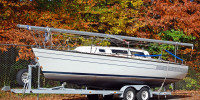
What's the Largest Sailboat You Can Trailer?
Own your first boat within a year on any budget.
A sailboat doesn't have to be expensive if you know what you're doing. If you want to learn how to make your sailing dream reality within a year, leave your email and I'll send you free updates . I don't like spam - I will only send helpful content.
Ready to Own Your First Boat?
Just tell us the best email address to send your tips to:
- New Sailboats
- Sailboats 21-30ft
- Sailboats 31-35ft
- Sailboats 36-40ft
- Sailboats Over 40ft
- Sailboats Under 21feet
- used_sailboats
- Apps and Computer Programs
- Communications
- Fishfinders
- Handheld Electronics
- Plotters MFDS Rradar
- Wind, Speed & Depth Instruments
- Anchoring Mooring
- Running Rigging
- Sails Canvas
- Standing Rigging
- Diesel Engines
- Off Grid Energy
- Cleaning Waxing
- DIY Projects
- Repair, Tools & Materials
- Spare Parts
- Tools & Gadgets
- Cabin Comfort
- Ventilation
- Footwear Apparel
- Foul Weather Gear
- Mailport & PS Advisor
- Inside Practical Sailor Blog
- Activate My Web Access
- Reset Password
- Customer Service

- Free Newsletter

Tartan 30: An Affordable Classic

Ericson 34-2 Finds Sweet Spot

How to Sell Your Boat

Cal 2-46: A Venerable Lapworth Design Brought Up to Date

Preparing A Boat to Sail Solo

Solar Panels: Go Rigid If You have the Space…

Leaping Into Lithium

The Importance of Sea State in Weather Planning

When Should We Retire Dyneema Stays and Running Rigging?

Rethinking MOB Prevention

Top-notch Wind Indicators

The Everlasting Multihull Trampoline

Taking Care of Your 12-Volt Lead-Acid Battery Bank

Hassle-free Pumpouts

What Your Boat and the Baltimore Super Container Ship May Have…

Check Your Shorepower System for Hidden Dangers

Waste Not is the Rule. But How Do We Get There?

How to Handle the Head

The Day Sailor’s First-Aid Kit

Choosing and Securing Seat Cushions

Cockpit Drains on Race Boats

Re-sealing the Seams on Waterproof Fabrics

Safer Sailing: Add Leg Loops to Your Harness

Waxing and Polishing Your Boat

Reducing Engine Room Noise

Tricks and Tips to Forming Do-it-yourself Rigging Terminals

Marine Toilet Maintenance Tips

Learning to Live with Plastic Boat Bits
- Sailboat Reviews
Four Trailer-Sailers And the Keel/Launch Problem
The paceship 23, american 26, yankee pacific dolphin 24, and aquarius 23 represent different solutions to the problem of easy launching.
In the early 1970s, when the fiberglass sailboat revolution was in full swing, so were the so-called swing keels. Three years after Richard Nixon was elected president, partly on the promise of ending the Vietnam War, U.S. planes still were bombing Cambodia, hippies and peaceniks were marching and both were flashing the V sign. In 1971 Sylvia Plath published “The Bell Jar,” Louis Armstrong died, the crews of Apollo 14 and 15 landed on the moon, cigarette advertisements were banned from television, and Joe Frazier outpointed Muhammad Ali to retain his world heavyweight boxing title.
On the domestic level, Americans were taking their leisure time more seriously than ever, taking to the highways in RVs and to the waterways in all sorts of new fiberglass boats. Magazines devoted exclusively to sailing began to appear. One of the most popular type of boats was the “trailersailer,” relatively light-displacement sloops with centerboards and swing keels, that could be stored in the backyard or driveway, towed behind the family station wagon and launched in about 45 minutes. Trailer-sailers promised yacht-style accommodations at an affordable price-in terms of both initial investment and annual upkeep.
Trailer-sailers never really disappeared from the sailing scene, but they haven’t been exactly an exploding market force either. But becuase we see indications that trailer-sailers are showing signs of increased interest from boat buyers, we thought we’d take a look at four early-and mid-19702 designs.
The Ballast Problem
For stability, a sailboat must have an underwater appendage such as a keel or centerboard, and ballast. Both are at odds with the concept of an easily trailerable boat that can be launched at most ramps. A deep fixed keel is untenable. One solution is to design a long, shallow keel, as seen on many Com-Pac boats, and older models such as the O’Day22. Unfortunately, windward performance suffers because there is little leading edge and foil shape to provide lift.
During the last few years, several builders have experimented with water ballast in the hull and centerboards for lift. Notable designs include the MacGregor 26, Hunter 23.5 and 26, and the new Catalina 25. The idea is to dump the ballast on haul-out to minimize trailering weight, especially important given the small size of the average car these days. The drawback, as we see it, is that the water ballast works best when it is well outboard, which is the case on race boats with port and starboard ballast tanks. Trailer-sailers with shallow ballast tanks on centerline can’t obtain the same righting moments because of the short righting arm. Plus, saltwater is not very dense, just 64 pounds per cubic foot (62.4 lbs. for fresh), compared to lead at about 708 lbs. While waterballast may be a viable option for lake and protected-water sailors, we don’t think it’s the best solution.
Looking back at the Paceship PY 23, American 26, Yankee Dolphin24, and Aquarius 23-we can examine several other approaches to the same problem.
Paceship Yachts was originally a Canadian builder, located in Mahone Bay, Nova Scotia (it was later bought by AMF of Waterbury, Connecticut). One of its first boats was the popular East Wind 24, introduced in 1963. The PY 23, designed by John Deknatel of C. Raymond Hunt Associates, was developed in 1974 in response to the trailer-sailer boom.
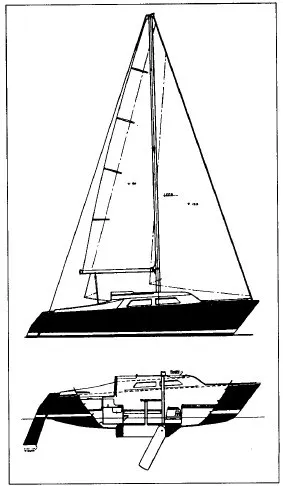
An early brochure describes the PY 23 as “a second generation refinement of the trailerable concept which eliminates the awkwardness in handling and sailing often present in the early trailerables.” Indeed, the boat was rated 18.0 for IOR Quarter Ton and 16. 9 under the MORC rule. Modern looks were derived largely from the flat sheer and reverse transom.
Instead of the more common swing keel, in which all of the boat’s ballast hangs on a single pivot pin, Deknatel gave the PY 23 a 40-pound centerboard that retracts into a 900-pound “shallow draft lineal keel.” This arrangement eliminates a trunk intruding into the cabin space, and places the majority of ballast a bit lower (it draws 1′ 9″ board up) than in boats, such as the Aquarius 23, in which the ballast is simply located under the cabin sole. The downside is a bit more draft, which means you need to get the trailer that much deeper to float the boat on and off. (We once owned a Catalina 22, which draws 2′ 0″ keel up, and often had to use a trailer tongue extension-built in-to launch and haul out.) Based on our experience, any draft under 2 feet should be relatively easy to trailer and launch. Difficulties seem to mount exponentially with every inch of added draft.
Like most trailer-sailers, the PY 23 has an outboard rudder that kicks up for beaching.
Recognizing that trailer-sailers are not built for rugged conditions, and that by necessity they are not big boats, we herewith list some of the more common owner complaints: no backrests in cabin, barnacles in centerboard well, not enough room in head, not an easily trailerable boat, rudder rot, and poor ventilation in forepeak.
On the plus side, owners say the boat is quick, well built, balances well, has good-quality mast and rigging, a comfortable cockpit, and a livable interior.
In all, we think this is a good example of the trailer-sailer. We like the keel/centerboard arrangement, even though it adds a few precious inches to board-up draft. It sold in 1974 for $8,150 base. Today, it would sell for about $5,100. A superior choice in our book.
Yankee Pacific Dolphin 24
Yankee Yachts of Santa Ana, California, was a major builder during the 1970s, known mostly for its IOR boats. The Pacific Dolphin 24, designed by Sparkman & Stephens, is a classiclooking boat, not unlike the more familiar S&S-designed Tartan 2 7. It was built between about 1969 and 1971, when it was replaced by the Seahorse 24, designed by Robert Finch, who helped design the immensely successful Catalina 27.
The reason, we surmise, was that the Dolphin has a long keel drawing 2′ 10″, and though the company initially thought it would appeal to trailersailers, it’s draft, plus 4,250-pound displacement, made it difficult to launch and retrieve. In contrast, the Seahorse drew 1′ 8″, displaced 2,800 pounds, and has a scabbard-type removable rudder.
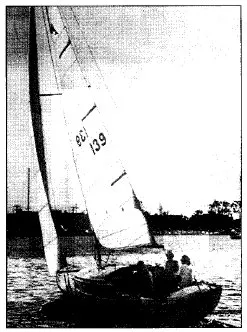
The Dolphin has 1,750 pounds of ballast, all in the keel. The attached rudder makes this boat a bit more rugged than most trailer-sailers, and its overall quality, including extensive teak joinerwork below, places it in a different category.
Owners report very few problems with the Dolphin other than a comparatively large turning radius, and cramped living quarters; most have only good things to say. An Oregon owner said, “Using a 3/4-ton pickup with a 390 engine we go uphill at 30 mph and down at 55. It takes us a couple of hours to rig and get underway, but it sure beats paying slip fees.” He also cites the Dolphin’s speed, saying he keeps pace with a Cal34, trounces a Balboa 26 and Catalina 27, and has only “lost” to a San Juan 21 going upwind. A Washington owner says she is very seakindly, with just the right amount of helm, though a bit tender due to narrow beam. Most owners use a 6-hp. outboard in the well, though one said he opted for a 15-hp. outboard for better performance, and because it can charge the batteries. Construction is reported as heavy.
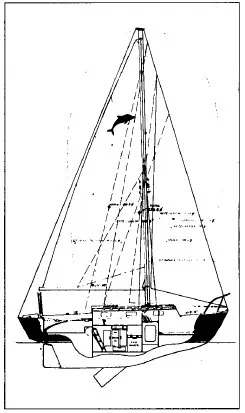
In 1971 the boat sold new for $5,995.Prices now are around $7,500, which for an original owner would have made it the best investment of these four boats. While we have always liked the Dolphin, we don’t view it as suitable for regular trailering. More likely, you’d keep it at a slip during the sailing season, parking it at home on its trailer after haul-out.
American 26
Costa Mesa, California was the epicenter of 1970s boatbuilding. American Mariner Industries is one company, however, better forgotten. It was in business from about 1974 to 1983. Its American 26 was a 25 first. A 1974 brochure says, “This 25-footer so completely justified our judgment as to the efficacy of our unique stabilizer keel and hull . . . that we have moved on to provide the trail-and-sail cruising enthusiast with a choice of two versions-the American 23 and the American 26.” This seems to imply that the same hull mold was used.
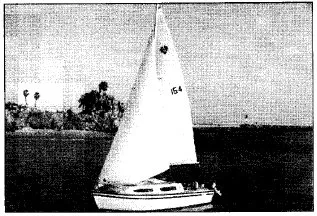
In any case, what is unique about this line of boats is the wide, partly hollow keel that makes a sort of trough in the cabin sole to provide standing headroom. It is not wide, but does run nearly the length of the main cabin. Ballast is 900 pounds of lead laid in the bottom of the keel. Draft is 2′ 4″ for trailerability, but there is no centerboard, and due to the keel’s extreme width, you can imagine that windward performance is poor. Unfortunately, we have no owner feedback on this boat to corroborate our assessment.
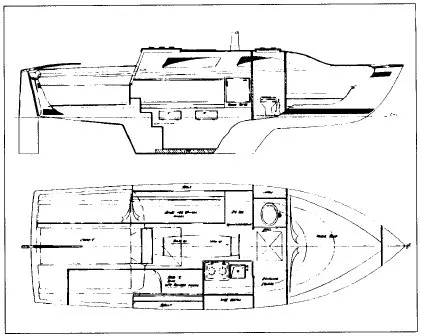
The boat sold new in 1974 for $8,995 base. The BUC Research Used Boat Price Guide says today it’s worth about $6,000. Frankly, this design, which severely compromises sailing performance for standing headroom, seems ill-conceived. One can only guess at how many people have cracked their skulls stepping up out of the trough.
Aquarius 23
Coastal Recreation, Inc., also of Costa Mesa, was around from about 1969 to 1983. It acquired the Balboa line of trailer-sailers, and for a time built the LaPaz 25 motorsailer.
The Aquarius 23, and its smaller sistership the Aquarius 21, were designed by Peter Barrett, a Webb Institute graduate and national champion in Finns and 4 70s. The Aquarius 23 is not much prettier to look at than the American 26, though it sails surprisingly well. Because highway trailering laws restrict the beam to 8 feet, the Aquarius 23 comes in just under at 7′ 11″ and relies on it for stability. ” Most of the 815 pounds of ballast is in the hull. A large center- board retracts fully into a trunk, which is more or less concealed in the cabin as a foundation for the drop-leaf table. A peculiarity is that persons sitting at the table are all on the starboard side, and the forward person is forward of the main bulkhead, essentially in the head, though there is a fore-andaft bulkhead making the toilet reasonably private (another important issue for trailersailers).
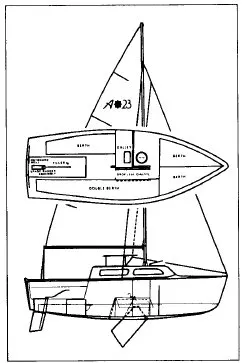
Like the Paceship PY 23 and many other trailer-sailers, the Aquarius 23 has a pop-top to provide additional headroom. We think this is more sensible than the American’s keel trough, but we do caution that pop tops can leak and aren’t designed for offshore use.
Another unusual feature of the Aquarius is the absence of a backstay and spreaders. To support the mast, the shrouds are led aft, reflecting, we suppose, Barrett’s one-design background. If not suited for wild and woolly sailing conditions, it is at least simple to set up, and that, after all, is the goal of most trailer-sailers.
Friends of ours bought an Aquarius 23 in 1970, and we spent a good deal of time sailing with them, including several overnight crossings of Lake Michigan. The boat handled well, was reasonably quick on a reach, and had more interior room than most 23-footers. Still, we were never enamored of its looks.
Complaints from owners include lost centerboards and rudder repairs (like the Yankee Seahorse, it is an inside, removable type), poor ventilation, poor windward performance when overloaded, tubby appearance, and lack of a mainsheet traveler. Many owners say they bought the boat for its shoal draft and large interior, but that cheap construction caused numerous problems.
The Aquarius 23, in the early 1970s, sold for $6,195; today it sells for about $4,000. Though our memories of sailing this boat are all rosy, we think there are better boats available.
Our preferred solution to the keel/ ballast problem in trailer-sailers is the traditional keel/centerboard as found on the PY 23, Tanzer22 andO’Day23, all of which we recommend. The keel/ centerboard configuration eliminates the trunk in the cabin, places ballast below the hull, and does not concentrate all of the ballast weight on a pivot pin, as is the case with swing-keel designs.
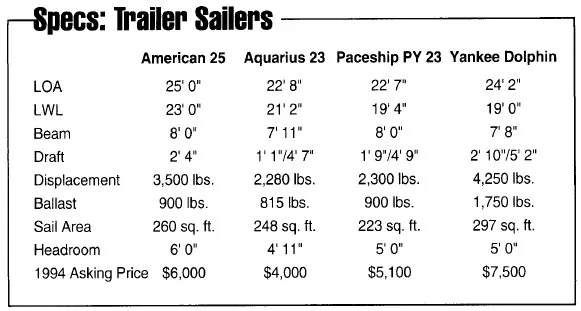
We do not care for the American 26’s hollow keel, believing that if you want standing headroom, either go outside or buy a bigger boat. Nor do we care particularly for narrow shoal keels without centerboards, because windward performance suffers, or boards that leave all the ballast in the hull-whether lead, iron or water-as ultimate stability is compromised.
How one solves the choice between interior space and sailing performance is a personal decision. We, too, appreciate spaciousness down below, but at the same time have always chosen boats that looked and sailed decently, willing to give up a few inches of elbow room for a boat we could feel proud of when rowing away in the dinghy.
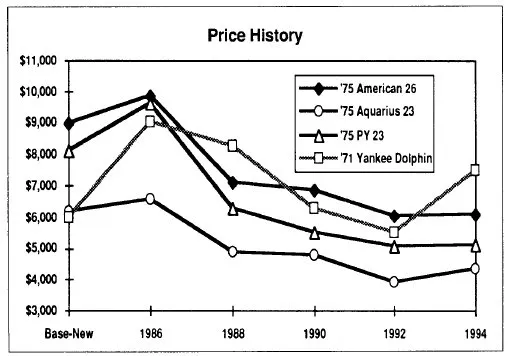
RELATED ARTICLES MORE FROM AUTHOR
So the only real complaint against the Aquarius23 is the author is not “enamoured” with it’s “looks”, whatever that means.
I think the Aquarius 23 beats them all for what they were designed for. A family of 5 and thats just what I have. The wide stern and blunt bow make it Large inside and can take a lot of wieght in the tail. I need function, rugged keel for beaching and shallow waters.
I had an Aquarius 21 for thirteen years in San Diego. I sailed it all the time, and made four trips to Catalina Island in it. It had some poor constructions flaws (like particle board coring for the deck), but it was inexpensive, and easily handled by one person. I loved it.
Hi Kevin. I’m looking at a Aquarius 21 project boat. The owner lost the title so I would have to re-title it, but can find a VIN / serial # anywhere. Can you tell me where it might be located?
I have owned and sailed a PY 23 for twenty years, and she has served me well. I have had off and on trouble lowering the centerboard, as it easily sticks in the up position (likely due to growths inside the trunk). It is difficult to gain enough leverage from inside the cabin to force it down. Other than that – the boat has been a trooper.
Have you ever evaluated the Sirius 21/22?
How about a review of the Sirius 21/22 by Vandestad and McGrewer?
LEAVE A REPLY Cancel reply
Log in to leave a comment
Latest Videos
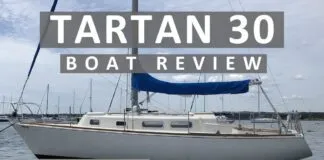
Tartan 30 | Boat Review

Fuel Contamination? The Baltimore Francis Key Bridge Collapse

Safety At Sea For You & Your Family – The Joe...

What’s The Best Vinyl Window Cleaner for Your Boat?
- Privacy Policy
- Do Not Sell My Personal Information
- Online Account Activation
- Privacy Manager

How to Launch a Sailboat with a Fixed Keel: A Step by Step Guide

Every sailboat has a keel. Whether yours is stationary (fixed) or flexible (moveable) depends on the model of your sailboat. If your boat has a fixed keel, you may struggle to launch the vessel into the water. You want to get better at this, but you’re not sure where to start. How do you launch a sailboat with a fixed keel?
To successfully launch a fixed keel sailboat into the water, follow these steps:
- Make sure you’re driving a heavy vehicle, such as a pickup truck or mid-sized SUV that doesn’t have front-wheel drive
- Reverse your vehicle so the trailer is near the water’s edge
- Put wheel chocks on your trailer
- Unhook the trailer from your towing truck
- Drive the vehicle away from the edge of the water so the attached rope becomes tight
- Take the chocks out from the trailer wheels
- Begin backing up until your sailboat is in the water
Admittedly, launching your fixed keel sailboat isn’t the easiest nor the quickest process. Therefore, in this article, we’ll explore the above steps in much more detail. We’ll also tell you everything you need to know about a fixed keel so you can better understand your sailboat.
What Is a Fixed Keel?
Okay, so your sailboat has a fixed keel rather than a moveable one. What does that even mean?
Well, first, let’s just make sure we’re on the same page about what a keel is. Your sailboat’s keel is the lowest element and the most longitudinal. Keels are made for counterbalancing and hydrodynamics in most sailboats, but they don’t do this for all.
If your keel is more hydrodynamic, then it’s supposed to go partially in the water. Fixed keels can be hydrodynamic, and if they are, then they’re strong enough to hold up the weight of your sailboat if necessary.
Okay, let’s talk more about fixed keels now. As we said in the intro, a fixed keel is stationary, meaning it will never move. Thanks to your sailboat’s fixed keel, you don’t have to worry about your boat blowing sideways in windy conditions.
Your fixed keel also distributes the center of gravity of your sailboat when in the water, moving this gravity under the waterline. Now, if your boat were to capsize from strong waves or the wind, it would pop right back upright again.
Not all fixed keels are the same. Your sailboat may be outfitted with one of two types: a full keel or a fin keel.
Full keels, despite their name, are not as long as the hull. They’re actually half the length. The design of a full keel is such that the aft edge is attached to a rudder while the forward edge has a vertical curve.
The stability a full keel lends you is advantageous. You can also rely on a full keel for grounding safely on your sailboat every time.
A fin keel has a broader shape, as its bottom cuts off at an angle. This type of fixed keel is often made of metal or wood. If you’re using a sailboat, a racing yacht, or any other shallow vessel on the water, the fin keel adds lateral resistance with its downward projection. That will make steering easier as well as help you keep the boat steadier.
Do Fixed Keel Sailboats Have Any Benefits?
You may have bought your sailboat without knowing some keels could move and others couldn’t. Through the luck of the draw, you ended up with a boat installed with a fixed keel.
Is your boat at an advantage or a disadvantage with a fixed keel? The answer is both. Let’s start with the benefits of a fixed keel sailboat.
- Centerboard-free: The first main perk of a fixed keel is that your sailboat foregoes a centerboard. If you’re not familiar, a centerboard is a type of keel that can retract. It fits in a sailboat’s hull via a slot. The centerboard pivots due to this setup. In shallower waters, the centerboard will lift so your center of lateral resistance is better.
Centerboards can come in handy, but due to their construction, there’s a good chance yours will jam up eventually, if not snap off entirely. A fixed keel won’t do that. It’s built into the boat and doesn’t bob and move with changing water levels. That increases the keel’s durability by a good margin.
- More freedom among your crew: With some other keel setups, if your crew doesn’t distribute their weight evenly, your risk of capsizing is higher. That’s not the case with a fixed keel sailboat. Move about as you will. Your boat will stay upright.
- Less sideways motion: If your sailboat experiences a lot of leeway or sideways motion in the water, a fixed keel will change that. The keel positioning lends the boat more stability.
- Great for capsizing prevention: As you’ve read on this blog, sailboats are incredibly prone to capsizing. It’s practically unavoidable. That said, with a fixed keel on your sailboat, the ballast of the keel may reduce your instances of capsizing. Also, as we mentioned before, the center of gravity distribution from the fixed keel makes it easier for your boat to come back up after capsizing. This can save lives in some instances.
In the interest of full disclosure, we should talk about the downsides to a fixed keel sailboat, as there are several of these.
- Trailering difficulties: This admittedly depends on the size of your keel and how deep it is. The deeper the fixed keel, the harder it is for trailering. Should your fixed keel sailboat exceed 25 feet, then you can’t trailer it at all. You’d need to keep it in a boatyard and launch it from there. This can be expensive and inconvenient.
- Weighty boat: Another problem with fixed keel sailboats is the keel adds extra weight to the boat. If you’re trailering, which we’ll explain more in the next section, that weight does add up.
- Shallow water troubles: Deeper keels have yet a second problem you should be aware of. That is, the displacement of these keels may make them unable to handle shallow waters without the keel scraping along and sustaining damage.
For more detailed information on keels, their types and effects on your vessels please read our last article here .

Launching a Sailboat with a Fixed Keel? Follow These Steps
You will indeed have your work cut out for you when trailering and launching a fixed keel sailboat, but it’s by no means impossible to do.
Here’s what you must have handy for the job:
- A trailer that fits your fixed keel sailboat
- High-quality wheel chocks
- Durable, fresh rope
You’ll then want to follow along with these steps to successfully send your boat into the water.
Step 1: Make Sure You Have the Right Vehicle
Not every vehicle is made for trailering and launching fixed keel sailboats. Ideally, you should drive a pickup truck or a mid-sized SUV. The heavier, the better here. After all, since the fixed keel sailboat can weigh more itself, you need a towing vehicle that can handle the extra weight.
Besides the weight of the vehicle, you should also make sure it has the right drive type. Front-wheel drive is not recommended. When you launch a fixed keel sailboat using a truck with front-wheel drive, the trailer weight will come down on the back of your truck. This causes traction instability to your front tires, which is not good.
Two-wheel drive, all-wheel drive, and manual four-wheel drive are all better options than standard four-wheel drive.
Step 2: Position Your Vehicle
Put your sailboat on the trailer and drive to the water where you want to launch the boat. When you get there, switch into reverse so you can align your truck or SUV until the trailer is right at the water’s edge.
At that point, the other crewmembers you brought with you (no, you can’t do this by yourself) need to set up the wheel chocks. These should go behind each of your trailer wheels.
Step 3: Separate the Tow Vehicle and the Trailer
With the wheel chocks secure, your crew should next remove the trailer so it’s no longer attached to your truck or SUV. At this point, the spare tire that comes with your trailer should be at its front. Otherwise, the tongue of the trailer won’t stay up, which can prevent the easy rolling you’re going to need for your sailboat.
Step 4: Attach the Rope and Pull It
You don’t want your towing vehicle and the trailer completely removed from one another yet. Take your rope and connect the two vehicles now. Then, drive your truck or SUV in very small increments until the rope is pulled nice and tight. It should not be strained to the point where it will break, but it should feel taut.
Step 5: Remove the Trailer Wheel Chocks and Move the Boat in the Water
You’re almost done at this point, but not entirely. Next, you want your crew to take the wheel chocks off all four wheels of your trailer. Now you want to reverse your truck or SUV yet again, going until your sailboat and the trailer are in the water. Neither should be barely in, but submerged.
Step 6: Let the Boat Float into the Water
Gravity should do its thing and your sailboat should naturally take to the water without you having to back in any deeper.
Step 7: Drive Forward and Re-Chock the Wheels of Your Trailer
Instead, you want to switch your truck or SUV into drive and get your trailer out of the water. When you’re safely out, your crew can reapply the wheel chocks on the trailer.
Step 8: Reattach the Trailer to Your Vehicle
The crew will also reconnect the trailer to your towing vehicle so you can drive it back home. You’re all done from there!
Now, the above eight steps anticipate that the conditions are ideal. In some bodies of water, you may run into shallow sandbars that make launching a fixed keel sailboat even more difficult. You don’t want your keel scraping along or even going through the sandbar, as that could hurt it. You could also end up ruining your boat that way if you’re not careful.
You’d want to use a boat ramp for launching your sailboat over a sandbar safely. Alternately, a courtesy dock near the boat ramp works just as well. Your crew will need to be with you to make a launch happen in these conditions.
They’ll attach the dock line to the courtesy dock to send your fixed keel sailboat with the trailer into the water deep enough for the launch.
More Tips for Sailing with a Fixed Keel
You now know how to launch your fixed keel sailboat in the water, but what do you do once you’re in there? We’ve compiled some handy tips for successful sailing with an immovable keel.
Research Where You’ll Sail Before You Go
The above sandbar situation is for the most part avoidable with a bit of research. Plan for where you sail and know which bodies of water have sandbars. Sometimes, water level and weather shifts can cause sandbars to appear where there had been none. Once you have a few preferred places to sail though, you can get a feel for which bodies of water may be most likely to have sandbars and then avoid those if riding in your fixed keel sailboat.
Gauge Water Depth Before Launch
Besides the level of the ground beneath the water, you also have to watch out for the depth of the water. Other sailboat keels can accommodate for shallower or deeper waters, but not a fixed keel. The keel length stays the same no matter how much (or little) water you’re sailing in.
The lower the water levels, the greater the chances of your fixed keel colliding with all that lies on the water’s floor. These could be sandbars, yes, but also damaging debris like seaweed or chunky rocks and stones.
If you’re sailing in the ocean especially, avoid venturing out during low tide when launching at the shoreline. There are far too many risks for your fixed keel sailboat.
Know What to Do If Your Keel Is Aground
Let’s say the worst did happen and your fixed keel ended up firmly lodged in a sandbar. You’d want to try to navigate your sailboat away if you can, getting your boat over or behind the sandbar.
Then it’d be a good idea to pull off to a dock as soon as you can and assess the damage. If your keel is just a little scraped up, then you should be able to keep sailing. For more serious harm, you’ll probably have to get your boat repaired.
In the future, avoid shallow conditions or waters with high floors, as they don’t do any favors for a sailboat with a permanently fixed keel.
Conclusion
A fixed keel on a sailboat cannot move, which means it has no freedom to retract in shallower conditions. These keels can reduce sideways motion and may even make it easier to recover after capsizing. That said, because the keel can be weighty and hard to work with, launching a fixed keel sailboat into the water is a whole complicated process.
The steps and guidance provided in this article should help you with a successful launch. Happy sailing!
I am the owner of sailoradvice. I live in Birmingham, UK and love to sail with my wife and three boys throughout the year.
Recent Posts
How To Sail From The Great Lakes To The Ocean
It’s a feat in and of itself to sail to the Great Lakes. Now you want to take it one step further and reach the ocean, notably, the Atlantic Ocean. How do you chart a sailing course to get to the...
Can You Sail from the Great Lakes to the Gulf of Mexico by Boat? 
You have years of boating experience and consider yourself quite an accomplished sailor. Lately, you’ve been interested in challenging yourself and traveling greater distances than ever before. If...
CHOOSING THE RITE TRAILER: BUNK VS. ROLLER
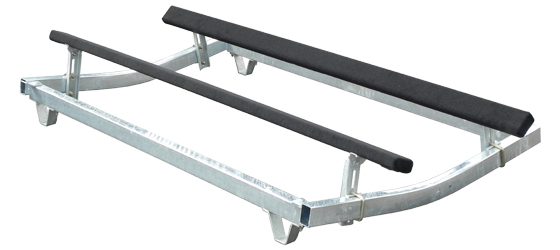
Bunk Trailers
Bunk trailers provide a classic, time-tested design and solid value. They offer superior hull support and security, making them an ideal choice for steep launching conditions and for boats that spend a lot of time stored on the trailer.
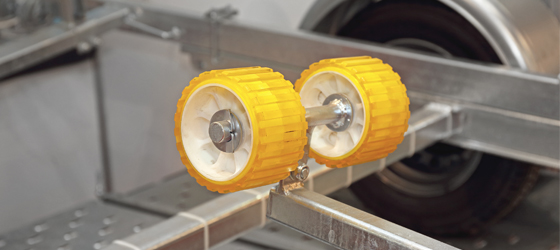
Roller Trailers
Roller trailers provide easy loading and launching in all conditions and water levels. For boaters who launch alone or those who face challenging ramp and tidal conditions, a roller model will get you loaded or launched in no time.
NEED HELP FINDING THE RITE TRAILER? FIND A LOAD RITE DEALER NEAR YOU
CHOOSING THE RITE MATERIAL: Aluminum VS. Galvanized

Aluminum provides natural corrosion resistance with less weight than a comparable steel frame, saving you fuel and valuable payload.

Hot-dipped galvanized steel provides exceptional strength and durability, resisting corrosion in challenging marine conditions, including salt.

CHOOSING THE RITE Axles: SINGLE VS.Tandem/Tri-Axle
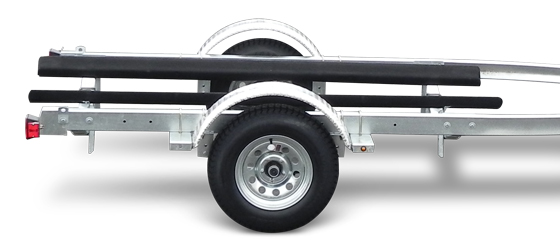
Single Axle
Single axle trailers are suited for boats up to about 20 feet in length. Your Load Rite dealer will help you select the appropriate configuration for your trailer.
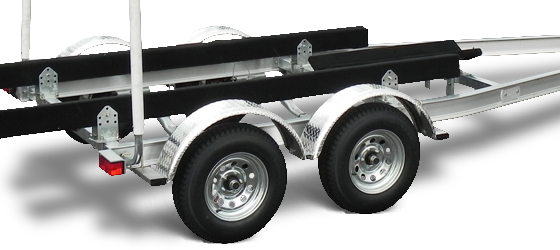
Tandem/Tri-Axle
Tandem and tri-axle trailers are suited for boats of roughly 20 feet and up. Your Load Rite dealer will help you select the appropriate configuration for your trailer.

You can enjoy the reliability and performance of a Load Rite trailer for your sailboat by specifying a custom trailer through your dealer.
We combine our modular pods with a keel board and winch stand options on any number of Load Rite or 5 STARR bunk models to conform to many sailboat applications. Each trailer must be specified on an individual basis. To get started, talk to your Load Rite dealer. Your dealer will collect the model number and other details about your boat and work with our Customer Service and Engineering staff to come up with a recommendation and a quote for your Load Rite trailer.
No Matches Found

My Cruiser Life Magazine
7 Best Trailerable Sailboats for Cruising
Many sailors balk at the idea of leaving their boat in the water at a marina. Slip fees are expensive, and maintenance bills get bigger the longer you leave a boat in the water. However, if you want a boat under 30 feet long, there are trailerable sailboats that will fit the bill.
Like any boat purchase, you’ll need to analyze precisely what kind of trailer sailer you want. Will a simple weekend sailboat suffice, or do you really need the best trailerable cruising sailboat you can find?
Here’s a look at some of the pros and cons of the best trailerable sailboat. Plus, we’ll look at how to compare them for your purposes.
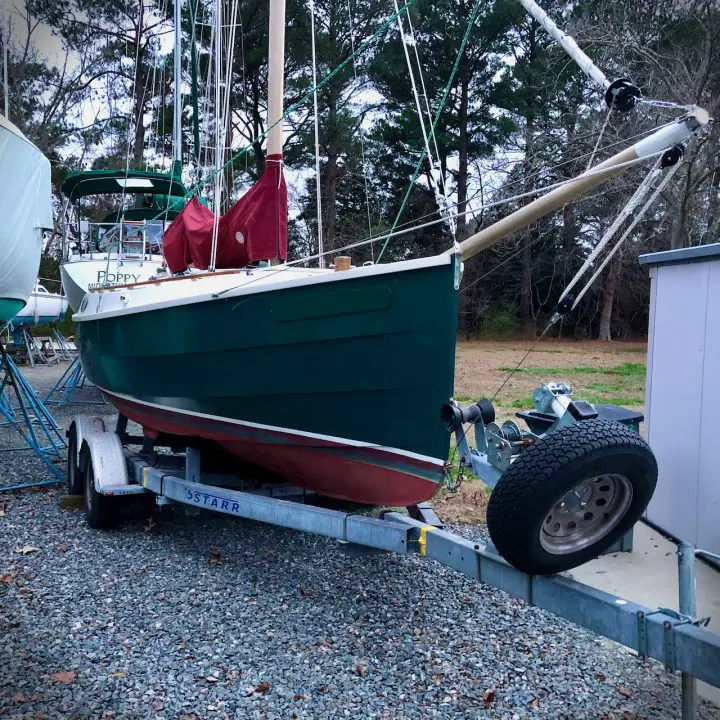
Table of Contents
Best trailerable sailboats, easy to launch trailerable sailboats, quick setup time, towing weight, catalina 22/25 “pop-top”, com-pac horizon cat for classic coastal cruising, marshall sanderling — small, portable, classy, west wight potter 19 — the tiny go-anywhere sailboat, seaward 26rk with retractable lead keel, corsair f-24 trimaran – sporty sailing, macgregor 26m — maximum speed meets maximum living space, long-range cruising boats, 7 best trailerable boats – a recap, what’s the best trailerable sailboat for a cruise, trailerable sailboats faqs.
- Catalina 22/25
- Com-Pac Horizon Cat
- Marshall Sanderling
- West Wight Potter 19
- Seaward 26RK
- Corsair F-24 Trimaran
- MacGregor 26M
We’ll get into more detail about each brand in my post today, so hang tight!
What Is a Trailerable Sailboat, Exactly?
For this article, the priorities for a trailerable sailboat are:
- Easy to launch
- Require minimum setup to launch and store
- Lightweight enough to be towed by the average vehicle
Before you can really classify a sailboat as trailerable, you need to evaluate and narrow your search criteria. Truthfully, 50-plus-foot ocean-going sailboats are regularly put on trailers. But that’s done commercially, on a big rig, with special permits for oversized loads, and even led cars.
That probably isn’t what most people mean when they think of a trailerable sailboat. But what is the priority here, the trailerable part or the sailboat part? Compromises are going to have to be made somewhere.
If you’re looking at the 20-foot-and-under sailboat crowd, finding a trailerable example should not be hard. Most sailboats this size are designed for trailers anyway since they aren’t the sort of boats people want to pay to leave in a slip year-round.
Things get more interesting when you look at the 20 to 30-foot boats. In this class, there are stout ocean-going cruisers with deep keels and lightweight centerboard trailer sailboats designed from the get-go to be trailered by the average car or SUV. The differences between these boats are night and day.
Sailboats often have a hard time at boat ramps. First, deep keels mean that the trailer must extend farther into the water than the average boat ramp allows. This means the ramp needs to go back far enough, and the trailer tongue needs to be long enough not to swamp the car.
If you have a boat like this, you’ll need to find the right boat ramps. Unfortunately, not all ramps are created equally. If your boat draws more than two or three feet on the trailer, you’re going to be limited to steep, paved, and high-quality boat ramps. Unfortunately, those aren’t standard features, so your cruising grounds are going to be limited.
Usually, ramps aren’t built steeply because they are often slippery. Your tow vehicle will need excellent traction and torque to pull your fully loaded boat out of a steep ramp. The steeper the ramp, the more trouble you’ll have.
The alternative to finding steep ramps is to use a trailer tongue extender. This lets you get the trailer into deeper water without swamping the tow vehicle. But it also means that the ramp needs to extend deep enough. Many ramps end abruptly. Allowing your trailer to sink off the edge is an excellent way to get stuck or pop a tire.
Pick a boat as easy to launch and retrieve as a similarly sized powerboat to remove all of these boat ramp problems. The soft chines of most sailboats will always require a little more water, but a swing keel and the hinged rudder raised mean that the boat can sit low on the trailer bunks. That way, you only need one or two feet of water to launch, an easy feat at nearly every boat ramp you can find.
The next consideration for a sailboat to be portable enough to call it “trailerable” is the amount of time it takes to step the mast and get it ready to cruise.
To accomplish this, you need a mast that can be stepped by a two-person team–maximum. Ideally, it will have some tabernacle hardware to enable one person to do the task for solo sailing.
There is an entire family of pocket cruisers that could ideally fit on trailers. But you won’t find the Fickas or the Falmouth cutters on my list, simply because they aren’t easy to launch or easy to rig. But, of course, they’re also too heavy for most vehicles to tow, which leads us to the final point of excluding them this trailable pocket cruiser’s list.
One of the most significant financial burdens the trailer sailer faces is their tow vehicle. You are all set if you already drive a two-ton dually diesel pickup truck. But if your daily driver is an SUV or light pickup, you need to think long and hard about the math of the towing equation.
Whatever boat you buy cannot exceed the towing rating limits of your tow vehicle. If you don’t have a tow vehicle, you’ll need to buy one. This will double or triple the cost of getting a trailer sailer in most cases. For the same money, you may want to look at a boat that stays in the water at a traditional boat slip. For the cost of a trailer sailer and a tow vehicle, you can probably step into a nice boat that is larger and more comfortable than any towable.
If you have a tow vehicle, you need a light enough vessel for it to tow. Most modern SUVs tow less than 2,500 pounds. Anything more than 5,000 will require a full-size pickup. Remember that the tow weight isn’t just the boat’s displacement—it’s the empty hull weight, plus the weight of the trailer and any extra gear you need to pack into the boat.
Finding a vessel that fits these limitations on weight isn’t easy. If the manufacturer’s goal is to make it towable, immediate limits are placed on the materials they can use. This means less seaworthiness since boats are built light and thin. As far as stability goes, lead keels are generally out, and water ballast systems or centerboards might be used instead. It doesn’t mean these boats aren’t safe and fun, but they aren’t designed for rough conditions, crossing oceans, or living on in the water full-time .
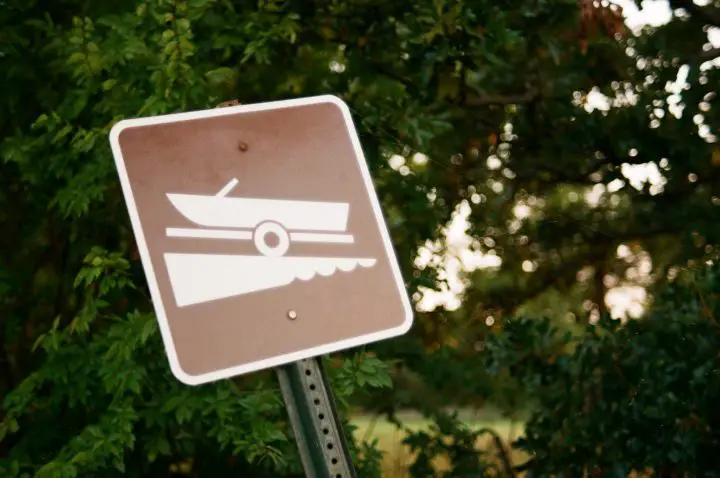
7 Best Trailerable Cruising Sailboats
There are more trailerable sailboats out there than you might imagine. Here’s a look at seven popular options of all shapes and sizes to give you a taste of what you might want to take to sea.
The boats here are selected for their storage and living space. With these boats and a little outfitting, you can spend weeks gunk-holing in the Chesapeake Bay or island hopping the Bahamas. If you broaden your scope to include daysailers with no cabin space, there are countless more options.
One of the worst parts of a small trailerable sailboat or pocket cruiser is the lack of stand-up headroom. One clever solution that you’ll find on some weekend sailboat types is the pop-top.
The pop-top is simply an area around the companionway hatch that extends upward on struts. So when you’re at the dock or anchor, you get standing headroom down below—at least right inside the pop-top.
You can build a canvas enclosure for your pop-top to use it in all weather. A pop-top makes your boat feel much larger than it is and allows you to move freely to cook or get changed down below or even do a nice boat bed area.
Later models of the Catalina Sport 22 and Capri 22s lacked this cool pop-top feature, so if you want it, you’ll need to seek out an older model on the used market.
Com-Pac has been building small sailboats since the early 1970s. They currently sell two lines, each with various-sized boats. All are well built, and a majority of their boats are trailerable.
Most interesting at the Com-Pac traditional catboats . The rigging is more straightforward than modern sloops, with only one large mainsail. Com-Pac boats come with a unique quick-rig system to make getting on the water fast and simple.
The Horizon Cat Coastal Cruising has a displacement of 2,500 pounds with a 2’2″ draft when the board is up. She has a separate head forward and space to lounge either topside or down below. The smaller Sun Cat has slightly few amenities but shaves off a few feet and pounds, making it easier to tow and it is one of these amazing small sailboats. Com-Pacs features stub keels, so their centerboard and hinged rudder do not take up space in the cabin.
On the sloop rig side, the Com-Pac 23 comes in a 3,000-pound traditional sailboat or a very interesting pilothouse. Both are incredibly livable for their size , with shallow two-foot-long fixed keels and high-quality construction.
Another option if you like catboats is the Marshall Sanderling. This salty 18-footer oozes traditional charm , all while being easy to sail and easier to tow. And while she has wooden boat lines, she has a modern laminated fiberglass hull.
The Sanderling has a 2,200-pound displacement, so tow weights will be around 3,000 pounds. At only 18-feet, she’s on the small side for cruising. The cuddy cabin has no galley, and the portable toilet is not enclosed. But that small size means a simple boat that’s easy to maintain and take anywhere.
An electric motor package is an exciting option on this weekend sailboat!
View this post on Instagram A post shared by @marshallmarinecat
You can’t mention tiny trailer sailers without touching on the famous West Wight Potter . These 15 and 19-foot pocket cruisers have earned a worldwide reputation as the ultimate go-anywhere coastal cruiser.
The West Wight Potter 19 offers the most living space for staying aboard and cruising. So even though its dimensions are diminutive, this little boat packs a lot in. There’s a single burner hotplate and sink and a porta-potty tucked under a cushion. Yes, it’s tight—but the company claims the little boat can sleep five people. Any more than two will feel pretty crowded, however.
The boat comes standard with a mast-raising system that a single person can manage alone. It has a daggerboard for a shallow draft of a half-foot when the board is up. The total towing weight is around 1,500 pounds, which means nearly any car can tow a West Wight Potter.
This little-known trailer sailer is produced at the same Florida factory that makes Island Packet Yachts. That should give you a little bit of an idea of what sort of boat it is—trailerable, yes, but also high-quality, beautiful, and built for cruising. In other words, it’s one of the nicest all round pocket cruisers and it feels like a much larger boat.
The Seaward is easily the saltiest boat on this list . It’s beefy and seaworthy. Instead of a lightweight centerboard, Seaward fits the RK with a bulb-shaped retracting keel. Other big-boat items include a Yanmar diesel inboard motor and an enclosed head. The spacious cabin of the boat features a double berth and is ready for salt water cruising.
According to sailboatdata.com , the tow weight of the 26RK is 6,000 pounds. With the keel up, the draft is 1.25 feet.
Multihull sailors need not feel left out from the trailer sailer club and the pocket cruiser. Beyond the ubiquitous beach Hobie Cat, there are not many options for catamarans. But trimarans are uniquely suited to be towed.
Why? For one thing, performance oriented boats like trimarans are based on it being built light. There is no ballast—a trimaran’s stability comes from its two outer hulls. Additionally, the living space is entirely housed in the central hull–the outer floats are small and sometimes foldable. Finally, there are no keels on tris, so they are extremely shallow draft and perfect for trailering.
If you’re looking for adrenaline-pumping sporty and fun sailing, it’s impossible to beat what a trimaran will offer. Let’s not beat around the bush—most of the trailer sailers on this list have hull speeds around five knots. The Corsair has no such limits, routinely sailing at 15 knots or more .
The new Corsair 880 trimaran has an unloaded weight of 3,659 pounds. It is trailerable behind a big SUV or small pickup and is probably the most fun sailing option that is trailerable at all.
An even more portable option is the older Corsair F-24. It has a light displacement of under 2,000 pounds—so nearly any SUV can tow it.
MacGregor owns the market on trailerable motor sailers since they more or less created the product to fit the bill. The MacGregor 26 is not like other boats. The design combines a planing powerboat with a centerboard sailboat. Imagine scooting along at 20 knots or more when the wind is down or enjoying a sporty sail on a breezy day–in the same boat.
The entire boat is built from the ground up for towing and long-range sailing. So if you want a big sailboat that you can tow behind pretty much any SUV, the MacGregor has to be on your list.
Depending on the model, the 26-foot-long boats have incredibly light dry weights of between 1,650 and 2,350 pounds. Considering the massive volume of the roomy cabin, the ability to tow such a large vessel opens up an entire world of opportunities for owners.
It’s not all good news, of course. MacGregor owners love their boats, but they are built light and are not ideally suited for offshore cruising or rough weather. But in bays and for coastal sailing on nice days, few boats can get as much use as a MacGregor.
The motorboat capability of the 26M and 26X might not appeal to hardcore sailors, but for those looking to maximize their use of the boat depending on the weather, their mood, or location, it makes a lot of sense.
MacGregor shut down in 2015, but the daughter and son-in-law of the original owners took over production and renamed the boat the Tattoo 26 . The company will soon release a smaller version, the Tattoo 22 .
If the 26 is a bit big to make your list of best trailerable small sailboats, consider the smaller Powersailer 19. It’s nearly identical to the 26, just smaller and lighter.
View this post on Instagram A post shared by Dale Roddick (@droddick33)
What Do You Want Your Trailer Sailer To Do?
After you’ve settled on how you will tow and launch your trailer sailer, now it’s time to dream about what you want it to do. Where will it take you?
The beauty of a towable boat is that you can travel anywhere. A boat in the water might take weeks or months to move a few hundred miles. But if you can attach it to your car and do 65 mph on the interstate, you could sail on the Pacific on Monday, the Gulf of Mexico on Wednesday, and the Atlantic on Friday.
We can divide our trailerable sailboats into three groups – daysailers, weekenders, and cruisers.
These are designed with open cockpits and no space to sleep. This is a majority of the sub-22-foot boats on the market. They are designed to be launched, play for the day, and return to the ramp or dock.
A weekender will have rudimentary sleeping facilities. Think of it as a floating tent—it’s not a five-star hotel, but you can sleep under the stars or get out of the rain. Conceivably you could stay aboard indefinitely, but it doesn’t have much room for gear. So most people are ready to get off after a day or two.
A cruising boat has sleeping, cooking, and toilet facilities built-in. These might be small and simple, but in any quantity, they mean you can disconnect from shore for a long time. Unfortunately, squeezing all of this into a tow-friendly package isn’t easy, and very few boats do it well.
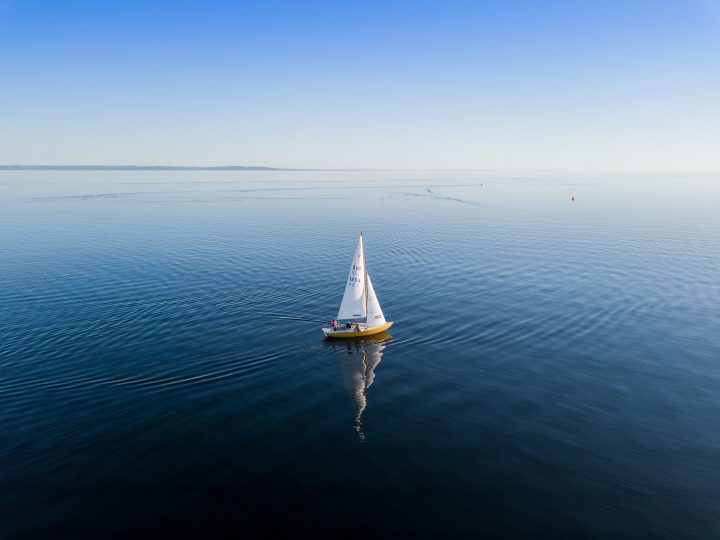
The best trailer sailor for your adventures will depend on many factors. Like any boat, whatever you decide on will be a compromise – boats always are. But there are plenty of choices out there, no matter what size your tow vehicle is and no matter what sailing adventures you have in mind.
What size sailboat is trailerable?
Even large yachts are routinely transported by towing across land, so the question is more of how big a sailboat can you tow? Your tow vehicle will be the limiting factor. The upper limit for most large SUVs and trucks is usually a sailboat around 26 feet long.
Sailboats are generally very heavily built, with ballast and lead keels. Sailboats specifically made to be trailer sailers are lighter. They may use drainable water ballast tanks instead of fixed ballast and have fewer fixtures and amenities.
To find the best trailer sailer, you need to balance the total tow weight, the ease of rig setup at the boat ramp, and the boat’s draft. Shallow draft boats with centerboards are the easiest to launch and retrieve.
Is a Hunter 27 trailerable?
No. The Hunter 27 is a one of those fixed-keel larger boats built from 1974 to 1984. The boat’s displacement is 7,000 pounds, not including trailer and gear. That alone makes it too heavy to tow by all but the beefiest diesel trucks.
Furthermore, the fixed keels had drafts between 3.25 and 5 feet, all of which are too much for most boat ramps. In short, the standard Hunter Marine 27 is too big to tow for most people.
On the other hand, Hunter has made several good trailer sailers over the years. For example, the Hunter 240 and 260 were explicitly designed for trailering. They have drainable water ballast and shallow keel/centerboard drafts less than two feet.
Is a Catalina 22 trailerable?
Yes, the Catalina 22 is easily trailerable and makes a wonderful weekend sailboat. In fact, there were over 15,000 Catalina 22s made and sold over the years.
The boat’s displacement is 2,250 pounds, which means your total tow weight with trailer and gear will be under 3,000 pounds. This is within the capabilities of most mid to full-size SUVs and light trucks. Be sure to check your vehicle’s towing capacity, of course.
The centerboard on the Catalina 22 is another factor in its easy towing. With the board up, the boat draws only two feet. This makes it easy to float off the trailer at nearly any boat ramp. You should avoid fixed keel versions of the 22 for towing unless you have access to extra deep ramps.
Matt has been boating around Florida for over 25 years in everything from small powerboats to large cruising catamarans. He currently lives aboard a 38-foot Cabo Rico sailboat with his wife Lucy and adventure dog Chelsea. Together, they cruise between winters in The Bahamas and summers in the Chesapeake Bay.
Can someone tell me why no other manufacturer makes pop tops? Those who have them, love them. Makes sense for head space with a trailerable boat too. Catalina stopped making them decades ago, yet people still swear by them. So, why isn’t there any newer models?
MacGregor put pop tops on many of its trailerables
Leave a comment
Your email address will not be published. Required fields are marked *
Save my name, email, and website in this browser for the next time I comment.

The Triad Advantage
Custom boat trailers built to your exact specifications..
For over 30-years, Triad Trailers has been the industry leader in custom boat trailers. Our custom trailer designs accommodate almost every type of sailboat and boating style since we start every project with custom plans to fit the exact measurement of your boat. If you order a Catalina 25 fin keel sailboat trailer, we build a Catalina 25 fin keel Triad Trailer. At Triad Trailers, we do not use the “one-size-fits-all” approach to building sailboat trailers.
To ensure the perfect customized fit trailer/boat fit, we build every trailer to order. The positioning of the hull support stands and the location of the keel support is laid out according to your sailboat. The components of our structural steel frames are cut and welded together according to your sailboats requirements. The axles, brakes, and tire capacities are chosen according to your sailboats specifications. We have designed over 1,000 different trailers for various sailboats either in production today or out of production for quite some time. If we don’t have a trailer plan for your sailboat in our files, we will locate either lines drawings of the boats hull, or an identical sister ship.
Just Some Of Our Triad Trailer Features.
- Manufactured in compliance with guidelines mandated by the National Association of Trailer Manufacturers
- Hull supported by retractable screw jack pads allowing hull work to be performed while your boat is on her trailer. (typically swing keel sailboat hulls’ are supported by hull support bunks, not screw pads
- Hot dip galvanized finish after the trailer chassis is welded
- Eliminator torsion axles and spring sprung axles have Hot dip galvanized axle beams
- Electric drum brakes have an E-Coat finish. Hydraulic drum and vented disc brakes have a Galvx coated finish
- Tandem axle and triple axle trailers are equipped with brakes on all wheels
- All axles are equipped with Super Lube spindles or equivalent. The Super Lube system allows periodic greasing of the bearings without removing the wheel or hub.
- Fully compliant over 80 inch trailer light kit which is fully submersible
- ST high speed trailer tires

Biggest Trailerable Sailboats

Last Updated by
Daniel Wade
June 15, 2022
Many sailboats up to about 27 feet in length can be trailered safely on American roads. These vessels are limited by weight, beam, and overall height.
In this article, we'll go over ten of the best large trailerable sailboats on the market. These vessels feature comfortable cabins, excellent sailing characteristics, and they all meet the requirements for towing on U.S. highways.
The best and largest trailerable sailboats are the Cal 20, the Catalina 22, the O'Day 240, The Islander 24, the Moore 24, the Cal 25, the Helms 25, the MacGregor 26, and the Nor'Sea 27. Most of these vessels can be towed behind a well-equipped truck or SUV.
We sourced information and vessel specifications for this article from sailboat manufacturers and record books. We also considered the opinions of sailors who own these vessels and sail them regularly.
Table of contents
What Makes a Sailboat Trailerable?
Trailerable sailboats must meet certain requirements in order to operate on American roads. The primary limitations are width (beam), as the vessel and its trailer must fit in regular traffic lanes and through tunnels. Another consideration is weight, as the vessel should be light enough to be towed by a 3/4 ton or 1-ton pickup truck.
Generally speaking, there's not a specific limit to boat weight in order to be towed. That said, most single and tandem-axle trailers can't exceed about 3,300 pounds per axle. With that in mind, the upper limit for a trailerable sailboat is around 7,000 to 8,000 pounds.
Keel type is an important factor to consider, as it determines how high off the ground the boat has to ride on the trailer. The majority of trailerable sailboats have a centerboard or swing keel that retracts for towing and beaching. Some vessels have shorter displacement keels or fin keels.
The maximum allowable for a trailerable sailboat is 8 ft 6 in. This is because these dimensions are the maximum limit for standard trailers on American roads. A larger boat can be transported on the road, but only as an oversize load.
In practice, very few trailerable sailboats have a beam of exactly 8 ft 6 in. The majority of large trailerable sailboats have a beam of between 7 1/2 ft and 8 ft 3 in. This makes it easier to negotiate tunnels and tighter traffic lanes.
Overall Length
The maximum trailer length for standard trailers is 65 ft, but it's nearly impossible for a trailerable sailboat of this length to meet the width requirements. In practice, the longest trailerable sailboats are around 30 ft in length or shorter. The average is about 20 to 25 ft.
In most states, the maximum height for a trailer load is 14 ft. This necessitates that the mast folds down and that the keel and vessel height combined doesn't exceed 14 ft. You must also take into account the height of the trailer, as a tall boat may not be able to clear highway overpasses.
10 Largest Trailerable Sailboats
Trailerable sailboats come in all shapes and sizes, including some large and roomy configurations. The vessels we chose range in length from 19 ft to 27 ft, and they offer the best accommodations on the market. Here are ten of the best large trailerable sailboats.
1. West Wight Potter 19
It's impossible to write an article about trailerable sailboats without mentioning the West Wight Potter 19. This vessel is perhaps the best and most capable in its class, and it offers surprisingly comfortable accommodations for a lightweight trailerable sailboat.
The West Wight Potter 19 is easy to sail fast and features a roomy cabin with a sink and space for a head. It's considered a pocket Cruiser, and it is very popular in coastal areas. Due to its lightweight construction, this fiberglass sailboat is trailerable behind an SUV or half-ton pickup.
The West Wight Potter 19 has positive buoyancy material throughout the whole, making it effectively unsinkable. Additionally, the mast and rigging collapse and set up in minutes. These vessels were produced up until recently, so they're common on the used market.
- Lightweight
- Rigs up fast
- Roomy cabin
- Relatively slow
The Cal 20 has been around for decades, and this capable racing boat is ideal the coastal cruising and sailing in semi-protected waters. That said, it's also quite seaworthy, as several have participated in TransPac races between San Francisco and Hawaii.
The Cal 20 is known for its low-profile cabin and easy trailering. At 20 ft in length overall, the Cal 20 is well within limits for trailering on American roads. While not the lightest trailerable sailboat on the list, a well-equipped pickup truck should tow it without issues.
The Cal 20 isn't the boat to choose if you're looking for the most spacious accommodations. That said, the cabin is functional, and the boat excels in handling. It's fast, safe, and agile, thanks to its long and thin profile. It's also a joy to sail in all kinds of weather conditions.
- Easy to sail
- Stable in high winds
- Spartan cabin
- Deep draft from the fixed keel
3. Catalina 22
The Catalina 22 is one of the most famous large trailerable sailboats ever built. It's one of Catalina's most popular models, and it was a big hit in the 1970s and 1980s. The Catalina 22 has a spacious and thoughtfully designed cabin with a wide companionway and a comfortable V-berth.
The Catalina 22 is a centerboard boat. This means that the keel retracts into the hull for trailering and lowers down easily using a system block-and-tackle or a crank. The vessel is 7.67 feet wide, making it easy to tow on typical American highways.
The vessel is still produced today, and over 15,000 have been built since 1969. This makes it one of the most popular sailboats ever, and hundreds are available on the used market for reasonable prices. Thanks to its superior handling and excellent design, the Catalina 22 is one of the best large trailerable sailboats available.
- Well-designed cabin
- Affordable iconic sailboat
- Minimal headroom
- Finicky companionway hatch
4. O'Day 240
The O'Day 240 is one of the more seagoing trailerable sailboats on our list. It's beamy and stable, and it handles well in rougher weather conditions. It has a surprisingly comfortable cabin for its size and measures just 24 feet in length overall.
The vessel's wide beam contributes to its stability. However, with a width of 8 ft 3 in, the O'Day 240 approaches the upper limit of trailerable dimensions. The vessel weighs more than comparably sized boats, so you'll need a more powerful vehicle to tow it.
The cabin of the O'Day 240 stands out. It features a V-berth, berthing aft, a galley, and space for a head. There's ample headroom throughout the cabin, which makes the O'Day 240 ideal for extended coastal cruising.
- Stable Spacious cabin
- May be too wide for comfortable trailering
- Unusual cabin design
5. Islander 24
Islander is known for its larger sailboats (28 feet and larger), though it has produced a few excellent trailerable models. We chose the trailerable Islander 24, as it's known in the sailing community for its speed, comfort, and easy handling.
The phrase "they don't build them like they used to" applies to the Islander 24. When this vessel was designed in the early 1960s, boat manufacturers used more fiberglass and produced thicker hulls. This practice is costlier and made the boat weigh more. But it produced stronger vessels that last much longer than their flimsier contemporaries.
This fiberglass sailboat is thoughtfully designed and is well-suited for coastal cruising in the 21st century. It features stronger construction than similar models, and its keel design encourages stable and comfortable sailing.
- Strong hull and deck
- Stiff sailing
- Great windward performance
- Small cabin
- Heavy trailer weight
6. Moore 24
The Moore 24 was the first in a new class of vessels called the ultralight displacement sailboat. It has the handling characteristics have a large keelboat but the dimensions of a coastal cruising trailer-sailer.
From the outside, the flush deck of the Moore 24 looks like it couldn't possibly accommodate a cabin. Closer inspection reveals that the vessel has a roomy cabin that resembles that of much larger boats. It features a galley, a head, a V-berth upfront, and attractive paneling throughout.
The Moore 24 is a pocket cruiser by all definitions. It's
an excellent choice for those looking for a trailerable and seaworthy sailboat. Though a bit taller than some other models, the vessel is still well within limits for on-road transportation.
- Excellent handling
- Large cabin
- Heavier than many other 24-foot sailboats
The Cal 25 is essentially a stretched version of the Cal 20. It features the same basic hull design with the iconic flush deck and streamlined cabin. However, it's faster, offers superior accommodations, and it's more seaworthy.
The Cal 25 is known for its stiff handling characteristics in high winds. This is primarily due to its 1,700-pound lead keel, which keeps it upright and tracking straight. However, this does increase the overall weight of the vessel, which is an even 4,000 pounds dry. Thankfully, this is within the towing capacity of most standard pickup trucks.
The interior of the Cal 25 resembles the cabins of larger boats. In other words, it doesn't feel cramped. There's a large sitting area across from the galley and partitions separating the V-berth from the rest of the cabin. Overall, the Cal 25 is an excellent compact sailboat for racing or cruising.
- Good accommodations
- Marginal headroom in some areas
8. Helms 25
The Helms 25 is a compact vessel with a true swing keel. Unlike a centerboard, which descends through the hull straight down, a swing keel swings down on the hinge and occupies less space inside of the vessel. With the removal of the centerboard trunk, the Helms 25 retains its trailerable properties while freeing up living space in the cabin.
The Helms 25 is long and fast but not particularly tall. It fits well on a trailer, and its rounded hull doesn't pound in choppy water. The cabin is comfortable and features a small but usable galley, a table with two seating areas, a V-berth, and additional berthing aft.
Some versions of the Helms 25 also feature a separate head area between the V-berth and the central living spaces. The Helms 25 strikes the perfect balance between comfort, seaworthiness, and trailerability. It's safe and fun to sail and sells on the used market for affordable prices.
- Spacious cabin
- Long, narrow, and shallow
- Not ideal for offshore sailing
- Too long for some trailers
9. MacGregor 26
The MacGregor 26 is larger and more modern than most of the sailboats on our list. As a result, it takes advantage of recent design developments that make it an excellent large trailer-sailer. At 26 ft overall, the MacGregor 26 is also one of the fastest vessels on our list.
At first glance, the dimensions of the MacGregor 26 seem unusual. The hull shape resembles a bathtub, and the vessel's high profile is notable. These characteristics make it stable and easy to handle, and they also give it exceptional headroom in the cabin.
The McGregor 26 came in numerous configurations, which are designated with letters such as '26D' and '26M.' These include various cabin window orientations, colors, accessories, and interior layouts. Some versions of the MacGregor 26 came with a dual rudder setup, which is uncommon in its size range.
- Modern design
- Excellent headroom
- Unusual shape
10. Nor'Sea 27
The final trailerable sailboat on our list is also the most capable. The Nor'Sea 27 is a true offshore sailboat with accommodations that rival any mid-size cruising sailboat. the Nor'Sea 27 is a full-keel displacement sailboat that's designed for stability and motion comfort. It's one of the beefiest sailboats that still fits on a trailer.
The Nor'Sea 27 features standing headroom throughout the cabin. It has a head, galley, and berthing area forward that converts into a table. The cabin is lined with attractive wood paneling, and the entire vessel has a very high level of fit and finish.
The Nor'Sea 27 is built for cruising, and it's ideal for longer voyages and offshore passages. If you're looking for a true cruising sailboat that stores well on a trailer, you can't go wrong with the NorSea 27. Due to its size and capabilities, you'll need a larger vehicle to trailer this vessel safely.
- Biggest cabin
- Full-size accommodations
- Offshore capable
- Too large for SUV towing
- Slow to rig and disassemble

Related Articles
I've personally had thousands of questions about sailing and sailboats over the years. As I learn and experience sailing, and the community, I share the answers that work and make sense to me, here on Life of Sailing.
by this author
Best Sailboats
Most Recent

What Does "Sailing By The Lee" Mean?
October 3, 2023

The Best Sailing Schools And Programs: Reviews & Ratings
September 26, 2023
Important Legal Info
Lifeofsailing.com is a participant in the Amazon Services LLC Associates Program, an affiliate advertising program designed to provide a means for sites to earn advertising fees by advertising and linking to Amazon. This site also participates in other affiliate programs and is compensated for referring traffic and business to these companies.
Similar Posts

Affordable Sailboats You Can Build at Home
September 13, 2023

Best Small Sailboats With Standing Headroom
December 28, 2023

Best Bluewater Sailboats Under $50K
Popular posts.

Best Liveaboard Catamaran Sailboats

Can a Novice Sail Around the World?
Elizabeth O'Malley

4 Best Electric Outboard Motors

How Long Did It Take The Vikings To Sail To England?

10 Best Sailboat Brands (And Why)
December 20, 2023

7 Best Places To Liveaboard A Sailboat
Get the best sailing content.
Top Rated Posts
Lifeofsailing.com is a participant in the Amazon Services LLC Associates Program, an affiliate advertising program designed to provide a means for sites to earn advertising fees by advertising and linking to Amazon. This site also participates in other affiliate programs and is compensated for referring traffic and business to these companies. (866) 342-SAIL
© 2024 Life of Sailing Email: [email protected] Address: 11816 Inwood Rd #3024 Dallas, TX 75244 Disclaimer Privacy Policy
- Sign In or Register
- RVs for Sale
- Research RVs
- Search Alerts
- My Listings
- Account Settings
- Dealer Advertising
- Keel Sailboat Trailer
Keel Sailboat Trailer RVs for sale
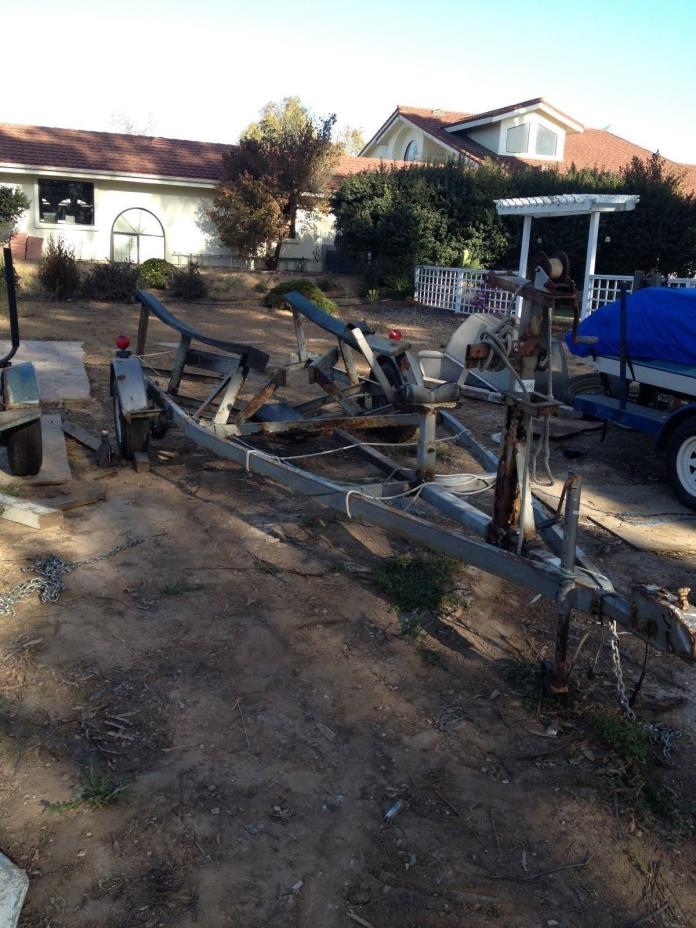
Capri/Catalina 22 Sailboat trailer for winged keel
Santa Maria, California
Posted Over 1 Month
Nice usable trailer from Capri 22 winged keel. Trailered will with boat on, licensed and registered in my name. Currently has magnetic lights attached but will install trailer lights for buy it now price. Both verticals, winch mount and bumper mount for under bow of boat need replacement, otherwise rust is surface only and should clean up

Sailboat trailer
Brandon, Mississippi
Make Custom Built
I am selling this because I sold the boat and the buyer did not want to trailer it. It was built to handle boats up to about 27 feet and under 9,000 lbs. I used it for a 26' Seafarer that was heavily customized and well above the standard weight for long term cruising. this is a smooth pulling trailer that will wet launch and retrieve without problems and would handle a fin keel drawing 3 to 5 feet. In order to put a full keel on this trailer you would probably need to alter the guides. Needs nothing but for you to buy and hook-up.
SAILBOAT TRAILER
College Station, Texas
Sailboat Trailer - Tandem Axle, Tires: Carlisle 7.50-16 LT SureTrail tires - 4 plus spare with less than 300 miles on them. Eight Fully adjustable hull supports. Can be adjusted from shoal draft to fin keel heights. Great for long hauling or bottom work. Trailer has a built in guide for directing keel to the center of the trailer for ramp haul outs. Bow support adjustable. Ideal for boats to 28 feet. 2 - 5/16" hitch ball included. Pictured is a 26' boat with 5' draft (boat not included) centered forward on the axles. 28' boat would be centered back 1' and maintain good balance for towing. Strongly built. Clean Texas Title. Location: College Station, TX 77845
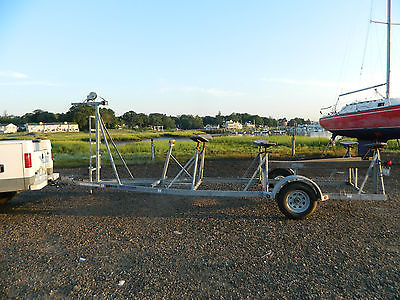
2008 Triad Sailboat galvanized float off trailer 5200 GVW
New Haven, Connecticut
For sale is a 2008 24' Triad brand sailboat trailer, 5200GVW. The condition is like new as the trailer was rarely used. It is completely galvanized including the hydraulic brakes. This trailer was designed for a J/24 but with the adjustable poppits/bunks could easily be used for different boats (J/22, Sonar etc. . .) The electric lights are all in good working order. The tires are in good shape with plenty of life left in them. The brakes are hydraulic. This trailer is set up to ramp launch/retrieve a boat. There are keel guides and a built in tongue extension. Also there is an adjustable bow stop with winch. Asking $4250 title in hand If you have any questions or wish to come see the trailer, please e-mail or call Mike (203)605-9521 or Tom (203) 464-2675 Local delivery available for an additional charge.

2006 Hostar dual axle Sailboat trailer 33-39 feet
Milford, Connecticut
Normal 0 false false false EN-US X-NONE X-NONE Before we modify this custom trailer to fit other boats I’m listing it here. This is a very well made 2006 Hostar. 13000 GVW, saddles rotate with boat and can be manipulated to slide or tilt so as not to exceed wide load. Overall length is 35 feet and 8 feet 6 inches wide. Should hold up to 9500lbs of cargo. If someone has their own saddles the modification would be relatively easy to fit this trailer.2006 Hostar dual axle Sailboat trailer. Was Custom made bt the Hostar trailer company to accommodate a Cross Current 33 with a removable keel. Includes 4 adjustable bunks or cradles that can be manipulated to slide or tilt so as not to exceed wide load specifications.includes 2- 80" wide & 2- 120" wide cradles. 6" x 2" x 1/4" rectangular steel main frame 4" x 2" steel cross beams 2" x 2" Steel Mounting rail Tandem 5,200 Torflex rubber torsion bar E-Z Lube axles Four 225/75R15 Load Range D Radial Tires on aluminum rims spare 225/75R15 Load Range D Radial Tires on aluminum rim Electric brakes on two axles with D.O.T. Wiring Breakaway Switch 2 5/16" ball hitch with safety chains Frame mounted swing away bull dog tongue jack w/ sand shoe Extra bright LED submersible lighting system galvanized frame & cross beams MFG Date December 2006 Model OBT 3300Please contact Tom via email or phone with any questions 203-464-2675 **I do have a clear title in hand and can offer a transferable registration to the new owner valid until 02/2017** A few people have asked and yes, the current saddles unbolt easily and can be removed. Click to View Image Album Click to View Image Album Click to View Image Album Click to View Image Album Click to View Image Album Click to View Image Album Click to View Image Album Click to View Image Album Click to View Image Album Click to View Image Album Click to View Image Album Click to View Image Album Click to View Image Album Click to View Image Album Click to View Image Album Click to View Image Album Click to View Image Album Click to View Image Album Click to View Image Album Click to View Image Album Click to View Image Album Click to View Image Album Click to View Image Album Click to View Image Album Click to View Image Album Click to View Image Album Click to View Image Album Click to View Image Album Click to View Image Album Click to View Image Album Click to View Image Album Click to View Image Album More than just a pretty picture. Try Vendio Image Hosting.
Normal 0 false false false EN-US X-NONE X-NONE Before we modify this custom trailer to fit other boats I’m listing it here. This is a very well made 2006 Hostar. 13000 GVW, saddles rotate with boat and can be manipulated to slide or tilt so as not to exceed wide load. Overall length is 35 feet and 8 feet 6 inches wide. Should hold up to 9500lbs of cargo. If someone has their own saddles the modification would be relatively easy to fit this trailer.2006 Hostar dual axle Sailboat trailer. Was Custom made bt the Hostar trailer company to accommodate a Cross Current 33 with a removable keel. Includes 4 adjustable bunks or cradles that can be manipulated to slide or tilt so as not to exceed wide load specifications.includes 2- 80" wide & 2- 120" wide cradles. 6" x 2" x 1/4" rectangular steel main frame 4" x 2" steel cross beams 2" x 2" Steel Mounting rail Tandem 5,200 Torflex rubber torsion bar E-Z Lube axles Four 225/75R15 Load Range D Radial Tires on aluminum rims spare 225/75R15 Load Range D Radial Tires on aluminum rim Electric brakes on two axles with D.O.T. Wiring Breakaway Switch 2 5/16" ball hitch with safety chains Frame mounted swing away bull dog tongue jack w/ sand shoe Extra bright LED submersible lighting system galvanized frame & cross beams MFG Date December 2006 Model OBT 3300Please contact Tom via email or phone with any questions 203-464-2675 **I do have a clear title in hand and can offer a transferable registration to the new owner valid until 02/2017** Click to View Image Album Click to View Image Album Click to View Image Album Click to View Image Album Click to View Image Album Click to View Image Album Click to View Image Album Click to View Image Album Click to View Image Album Click to View Image Album Click to View Image Album Click to View Image Album Click to View Image Album Click to View Image Album Click to View Image Album Click to View Image Album Click to View Image Album Click to View Image Album Click to View Image Album Click to View Image Album Click to View Image Album Click to View Image Album Click to View Image Album Click to View Image Album Click to View Image Album Click to View Image Album Click to View Image Album Click to View Image Album Click to View Image Album Click to View Image Album Click to View Image Album Click to View Image Album More than just a pretty picture. Try Vendio Image Hosting.
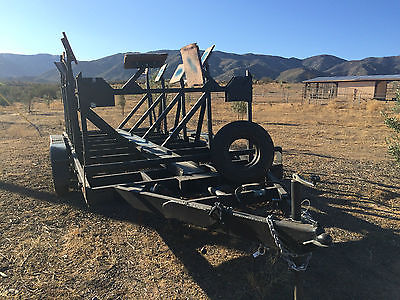
trailer for a 30' sailboat weighing less than 12,000 pounds
Palmdale, California
Make Homemade
25' long by 108" wide Sailboat trailer with 10 adjustable pads and a long channel for the keel to sit on. It is a home made trailer used to haul a Catalina 30 to Eureka CA from Weaverville CA. I picked up this trailer to get a Catalina 28 from Lake Texoma in Texas to Redondo Beach CA. We had a great trip out there and back with out any problems. It has 3 axels with electric brakes along with and emergency braking system and a spare tire. It is set up with a LED lighting system with red Brake lights, red running lights and amber side lights. The trailer is set up with tubes for wide load flags on the four corners of the trailer. It has a crank up trailer jack for the tongue with a flat foot or a steel wheel. Not sure you can push the trailer around on the wheel. We guess that the trailer weighs around 2,000 pounds, We never weighed the trailer. I was able to do a bottom job On the Catalina 28 before I put the boat in the water. It was easy because I could let the boat sit on four pads, paint the bottom then switch the pads to four other pads and paint where the first four pads were. I have just gotten the trailer registered with a homemade 6 digit CA VIN number given by the CHP and a permanent license plate issued by the DMV. If you need a trailer to move a 12,000 pound sailboat around or need a trailer to store a boat on this is a great trailer for you.
Custom Heavy-Duty Sailboat Trailer: 13,660 lbs/28 to 34 ft.
Shreveport, Louisiana
Custom Heavy-Duty Sailboat Trailer: 13,660 lbs/28 ft. to 34 ft. boat capacity. I had this heavy-duty sailboat trailer specially built to haul and launch my 30' Hunter Tall Mast (10,800 lbs. dry) with lead wing keel. After bringing it to Louisiana from Oklahoma, I've used it exactly once (at my lake to haul my boat out of the water to do a bottom job and put it back in the water when I finished). The trailer has been in fresh water for a total of 30 minutes. It's been on the road only from Oklahoma to Louisiana (about 320 miles) and has never been on the open road with a load. It's built to efficiently load a big boat with ease, solidly transport and single-hand launch big bodied boats in the 28' to 34' range, weighing up to 13,660 (14,000) lbs with either full keels, fin keels or wing keels up to 6' draft. Overall tongue-to-tail length: 22 ft. Overall beam width: 9 ft. Total dry weight: 1,200 lbs. Dual axle (two 7,000 lbs. each torsion bar axles) 13,660 lbs registered total load with electric brakes. Fifth wheel is a 235/75.16 radial and supports up to a 7,000 lb. direct load at the tongue. 12" extra wide welded diamond pattern plate steel fenders. 3' tall from ground to top of bow fender. 3'5" tall from frame to top of individual pads. 5'6" tall from ground to top of front bow pad. 5'4" tall from ground to top of front crank. Four main tires and one spare (5 tires total)are Goodyear Wrangler size LT266/75.R16 radials with medium tread. Frame made of welded 6" industrial C-channel box steel with welded 3" C-channel steel cross members. Six box steel, adjustable, padded uprights with 360 degree 12" sq. swivel pads. Plus a 5' wide x 6" flat padded bow rest of welded 3" C-channel box steel with two adjustable threaded uprights. Double-width (approx. 20" wide), adjustable keel rest 6' long of welded industrial C-channel steel. Four vertical box steel extensions with 15' removable schedule 40 PVC side guides for easy visible launching. Additional in-line 15 foot box steel extension tongue with welded plate stop and adjustable crank-up rest under the rear of the frame for storage. With extension tongue out, overall length is 37 ft. for launching far out into the shallowest of water. Industrial gauge crank-type tongue jack with drop leg axle holding the fifth wheel rated at 7,000 lb. support. Heavy-duty Bulldog 2 5/16" coupler rated at 12,500 lbs. Sandblasted then painted with 3 coats of water-resistant Rustoleum marine grade bright white gloss lacquer with commercial reflective DOT-approved tape on frame sides. Clean, transferrable title. $ 5,500.00Buyer picks up the trailer at my location: Cross Lake, Shreveport, Louisiana. Or, if you'll email me with particulars, I can either arrange to have the trailer delivered to you or bring it to you myself for a reasonable additional fee if you live within 350 miles of Shreveport, LA. In any case, I'll work with you to get the trailer to you as easily and quickly as possible.

Heavy duty TRAILER
High Springs, Florida
I used to pull my Bobcat on this but sold it a while back. This is super easy to pull and has extra supports down middle for hauling weird things like my small sailboat with a fixed keel. I had 2 x 12 planks on it. Just had NICE tires put on and a fresh paint job. She will last a long time as all angle iron is super thick. My ford 9n tractor would fit on it as well. Feel free to make me an offer. If you need to register it just take to scales take receipt to tag office as home made. That's it. I never had a need for tag just stuck magnetic lights on it Farm trailer. The actual inside frame size is 58"wide 121" long and tongue is 48" $400 or best offer can be seen on Hwy 41/27 south side of High Springs at Star Plaza. I live close. 352-284-9682 I'm Capt. Rhan Will consider some trade / I like horse trading just ask but need cash for wife that likes to eat. The price I have on the sign was what I had from another item I sold so please disregard. If you buy it I can for a price put a ramp/gate on it. "Your Call" Thanks

14' TRAILER see photos
I used to pull my Bobcat on this but sold it a while back 4000lb. This is super easy to pull and has extra supports down middle for hauling weird things like my small sailboat with a fixed keel. I had 2 x 12 planks on it. Just had NICE tires put on and a fresh paint job. She will last a long time as all angle iron is super thick. My ford 9n tractor would fit on it as well.The frame is aprox 10' long X 5' wide and tongue is 4' making it 14' total. Takes 2" ball and can be hauled with a small car. Feel free to make me an offer. If you` need to register it just take to scales take receipt to tag office as home made. That's it. I never had a need for tag just stuck magnetic lights on it. Farm trailer $700 or best offer can be seen on Hwy 41/27 south side of High Springs at Star Plaza. They call this 16782 NW State road 45 I live close. Cell # 352-284-9682 I'm not good at texting but will try. I'm Capt. Rhan Will consider some trade / I like horse trading just ask but need cash for wife that likes to eat. The price I have on the sign was what I had from another item I sold so please disregard. If you buy it I can for a price put a ramp/gate on it. "Your Call" Thanks
Morse Overland Marine Hydraulic Trailer 30,000 GVW. 6 Hydraulic Arms & Air Ride.
Stockton, Missouri
Make Morse Overland Marine
Morse Overland Marine Hydraulic Trailer. Power boats and sailboats to 40' + Feet. 5k Miles since recondition. Tandem air ride 15,000lbs axles (Oil Bath and Also EZ_Lube Grease) You decide what to run, I run grease but have run oil too, both work fine. 30,000 gvw. 6 hydraulic arms that power up and down with the push of a button and have 10,000lbs lifting power each & all operations have overload & fault protection, air ride suspension lets keel heights from 3" off the the ground to 12" off the ground. Trailer will accommodate shoal draft Sailboats, Wing keel & fin keels, deep draft sailboats up to 7'+ drafts and single or twin power boats. Pickup and set boats without the help of a crane or travel lift from stands! Landing wheels for boat ramp. Wet launch and retrieve boats with ease in less than 5 min and the best part its safe and easy! Adjustable hitch up & down to adjust ride height, make loading and unloading easier & adapt to any tow vehicle height. We've used this trailer behind several different trucks from 3/4 ton trucks (just moving the trailer around) to tandem axle semi trucks cross country all with no issues. Typically we use it behind a 450 or Chevy 1 ton for boats up to 10,000 lbs. larger boats of course behind larger tow vehicles. Air system and hydraulics are completely stand alone and need nothing additional to operate, you can move this trailer around the yard with a tractor if you wanted to and still run all the hydraulics and air system without the need to connect it to anything! Trailer opens up to allow you load and unload from jack stands without a crane. Recondition consisted of the following - (Complete media blast, epoxy primer and paint. Complete new hydraulic system, 50' wired remote, Hydraulic & Air valves also have wireless capability if needed, Antenna and box would be required to go wireless but valves will accommodate wireless, new hydraulic lines, new air lines, new air valves and all new air fittings, new air compressor, bearings, races, seals, caps, plugs, brake pads and brake system, tires, new wiring, new led lighting, all new bushings on axle swing arms & pads, new wood and rubber on pads, new carpet, pins, keepers, stops & more I'm sure that I am forgetting. Trailer is basically all New). Safety chains This is the big one - (Check Valves on ALL lift cylinders). New fenders. New Interstate SRM4D Battery Cell. Battery bank will charge when plugged into vehicle too. Battery operates trailer and air system continuously for over 1 hour before showing signs of slowing down and needing to either be plugged into the tow vehicle or charged remotely with a standard battery charger. We have never charged with a charger just always charged up when driving down the road plugged in. Pretty simple setup really. Main frame is 8"x8" 1/2" square tubing that is sealed and oil filled, oil prevents the insides from rusting. (there is 10 gal of oil inside frame & frame is pressure tested for leaks and has none!) All stainless steel pivot pins & bolts. Pad arms and keel beams are dipped galvanized. Pad insets and extensions are also galvanized. Every moving part has a grease zerk and is well greased too. All Stainless pins are removable too. All pad arms are galvanized, painted Metallic Green (I didn't like the galvanized look). Braking system is Electric over Hydraulic. The braking system is new with a break away system and backup breakaway battery. Trailer is 100& DOT Legal, road ready and will pass a DOT inspection hands down no questions! Braking system pump is mounted in the trailer and all that is required in your tow vehicle is a electric brake controller or like our truck a built in brake controller from the factory works fine as well. Brakes are all Disc and all 4 wheels brake. We've had a 18,000lbs sailboat with a 6' draft on this trailer and it handled it fine with no issues at all, road smooth down the road. This is a very heavy built trailer and will last forever with the right maintenance and care! Trailer tracks straight as a pin and smooth as a feather loaded or unloaded. Unloaded shut-off the front bag air up the back set of bags & roll through the tolls with 1 less axle on the ground, plus less wear and tear only using 1 axle on the ground. All air bag can be individually turned on or off. All trailer parts are common parts (nothing really special) if a break down happens on the road you won't be needing to make or buy custom parts to get rolling should anything happen. The only reason we're selling this trailer is we have a new larger hydraulic trailer arriving soon, so this one is going to go. We have 1 other hydraulic that doesn't have open frame capabilities as well. This is a good trailer at a reasonable price; price a new one, you'll spend $75,000 for a comparable trailer plus wait 6 months to get it. Then when you get it work out all the kinks for the next few hauls too, I've been there. Message me any questions you have, I have more pictures of the trailer loaded and unloaded or if you want new pictures let me know! Also mileage on the trailer is now 5,000 miles since rebuild it just came home from New Jersey with a 30' sailboat this week. Outer frame painted metallic green, logos & numbers will be removed before pickup/sale. Trailer year model is either a 2011 or 2012, (cannot remember off the top of my head) message me if you need to know and I will look at the title, Clean and Clear Missouri title as well. Thanks for looking!
Narrow Results
Current search reset all.
- Keyword: keel sailboat trailer
- Custom Built (1)
- Homemade (1)
- Morse Overland Marine (1)
- Connecticut (3)
- California (2)
- Florida (2)
- Louisiana (1)
- Mississippi (1)
- Missouri (1)
- Search Title Only
- Has Picture
- Include Sold Listings
Showcase Ads

2016 Airstream Sport

2017 Columbus by Forest River F377MB Grey

1989 Fleetwood Bounder Standard
Lake Butler, FL

2017 JAYCO 29 QBS

2011 KZ Spree
Centerville, IA

2013 Thor Windsport 33G
Create Alert
Please, name this search
Select Interval
Alert Successfully Created
(281) 844-4458
Welcome to Custom Sailboat Trailers

Trailer Facts
- We build galvanized sail boat trailers
- Some of our trailers are refurbished.
- They are all float on trailers
- We build extensions for launching
- Our used trailers are rebuilt stronger
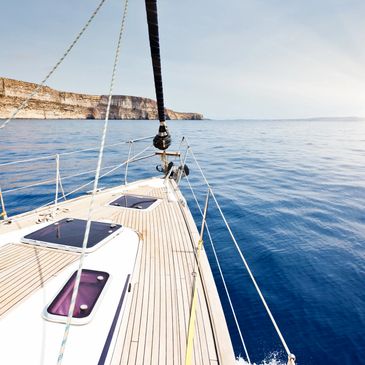
- We also move boats
- Transport Boats
- Trailer Parts
- Tongue extensions
- Side Guides
- Safety Chains
Interesting Facts
- In 2008 the EPA took the lead and nickel out of the hot dipped galvanize. I bought all the hot dipped galvanized frames i could,built before 2009 at scrap prices,so the trailer manufacturers could buy the aluminum to get a head start in the aluminum trailer business. Some of the trailer builders that did not get in the race,went under.Sportsman trailers in Texas was one of them. I bought about 200 of there frames. These frames were all built for mono hulls.I build my sail boat trailers with these frames. I go up with a 2" galvanized pipe,then weld two 3/4" nuts near the top.I brace the risers with two are three 1 1/2"x1/4" angle iron braces with a 1 1/2" pipe telescoping up and down with a swivel pad or runners.
- J 22 and J 24 trailer fits most any boat with a deep draft.The axles are on slides U-bolted to frame so you can add another axle.
- This trailer is 30 ft . It will adjust to any sail boat are mono hull boat. It is galvanized It is 42 years old. I has the good galvanize.and great American steel.
- Galvanized with three 5200 lb axle, 10 risers, adjustable to fit deep drafts
- 25 to 28 ft shallow draft or swing keel
- Painted trailer with 10 risers, 37ft long, with three 5200 lb axles,surge brake on two axles. It is ready to go. Call it will sell fast.
- This trailer carried the boat 10,000 mi. It is for sale for $2,500.I will add a bow stop
- Yard trailer that can be converted later for road trailer we can add one more 4500 lb axle and adjust the bow stop. The bow stop is U-bolted to the tongue. When you have completed the work and ready for the road. We can assist you in completing the trailer.
- Rubber bushing under keel board to take the shock off the keel.
Painted trailer for Catalina 25
- Hunter 26
- Oday24
- $2300
- 24 ft frame for 30 ft boat for three axles
- This trailer was made for a 5500 lb boat. We are able to add another slide with axles, brake, and fenders to accommodate an 8000 lb boat. Also the two axles were on slides U-bolted to frame.
- J27 1985 had to add another axle. It had 700 lbs of water absorbed in hull. By having axles on slides, we saved him about $2200.One happy camper.
more trailers
- Trailer on right, before uprights we go up with 2" galvanize pipe with 1 1/2" to telescope up and down with swivel pad on top.On top of 2" we weld two 3/4" nuts to hold the 1 1/2" That is a big bolt.
- Trailer frame before up rights installed
- This picture is to show you the extensions with tires we build.We can build any length. We also build extensions for the tongue.These are built with 3x3 tubing,no wheels. if they are under 8 ft we can ship for under $50.
Photo Gallery
Copyright © 2022 Custom Sailboat Trailers - All Rights Reserved.
Powered by GoDaddy

- Forums New posts Unanswered threads Register Top Posts Email
- What's new New posts New Posts (legacy) Latest activity New media
- Media New media New comments
- Boat Info Downloads Weekly Quiz Topic FAQ 10000boatnames.com
- Classifieds Sell Your Boat Used Gear for Sale
- Parts General Marine Parts Hunter Beneteau Catalina MacGregor Oday
- Help Terms of Use Monday Mail Subscribe Monday Mail Unsubscribe

Trailering and Launching a Wing vs Swing Keel
- Thread starter TortolaTim
- Start date Apr 1, 2016
- Catalina Owner Forums
- Catalina 22
I'm looking to finally pull the trigger this spring and get a trailerable C22. I know that a swing keel will work fine for me, but I don't want to limit my options by eliminating wing keels either, but am a little concerned about launching. Is there any big difference or added challenge in launching the wing keel? I'm driving a Dodge Durango with factory towing package, so I know weight will not be a problem, I'm just concerned about how much farther down the ramp I'll have to back down to float the boat. The low maintenance aspects of the wing keel are appealing, but I'm concerned that most of the ramps up here are designed for fishing boats. Anyone have any experience or advice regarding my situation? Thanks in advance for any help.
The lack of maintenance and stability provided by a wing keel is worth any additional effort in launching and retrieving. Ramps are rated by effective length and the slope of the incline. To launch a sailboat with a fixed keel a long and steep ramp is preferable but there are ways to get around it. A concrete ramp may or may not have a drop off at the end. Obviously a short one with a drop-off at the end is not any good but a short one with a continued gradual slope and somewhat solid dirt bottom might be just fine. For shallow ramps find a boat trailer with a tongue extension (pretty common pairing with fixed keel trailer boats). This tongue extension will allow to push the trailer further back until the boat floats. Others are successful in pushing a regular trailer down a ramp by disengaging it from the vehicle and tying a strap to it so that it can be retrieved. Do your homework on the ramps around the lake to find out those that are usable, look for a boat with a trailer that has a tongue extension and by all means choose a boat with a fixed keel. There are some trailer boats with a short fixed keel and a centerboard combo. A centerboard is not ballasted and the associated maintenance is much less intensive than that of a ballasted swing keel. Look at the Precision line of boats.
I have a fixed keel and it requires chocking the wheels, attaching a tow strap and then driving forward until tow strap is fully extended - then removing chocks and allowing the trailer to back down the ramp until fully submerged and boat floats free. It's a bit more work, but it isn't as hard as it sounds. A tongue extension would have to be 30 feet long to work - and the amount of torque and other complications of a tongue extender made a tongue extender not feasible. I would not shy away from the wing keel just because of launching or retrieving.
watercolors II
The lower the hull on the trailer the easier to launch and especially retrieve back on to the trailer. As stated, putting the boat back on the trailer is the hard part! So, when looking at sailboats I recommend measuring from the ground up to the water line on the hull, some boat just sit very high because of the trailer configuration. The Catalina 22’s have a stripe along the lower part of the hull and the water line in the water would be about 1 inch below this line. My 22 is 41 inches to this line at the trailer axle to the ground, the hull is as low as it can sit on this trailer and I have to back into the water till the rear bumper is wet to put the boat back onto the trailer. Different ramps have different slopes so, my vehicle would have to be placed at different depths on other ramps. At an average ramp slope, I would figure almost 1 foot into the water for each inch of height on the trailer. My trailer axle is about 31 feet from the water edge at a man made lake, the ramp would be steeper than at a natural lake from my experience. As these fellows have stated, the biggest problem is the length of the ramp. When power boaters put their hulls on the trailer, they gun the engine to help slide the hull up the slopping trailer, over many times and many seasons this prop wash pushes the lake bottom away from the very end of the paved ramp and creates a hole for you to back or drop the trailer wheels into. With the weight of the boat on the trailer even a 4 wheel drive vehicle cannot pull it out on a wet smooth ramp. All keels have to be maintained, I did my keel 23 years ago for the first time, it sits at a dock for 6 months a season on a Pennsylvania lake. I bottom paint my hull every 2 to 3 years with a little touch up on the keel and I re-finished this keel 3 years ago.
TortolaTim said: I'm looking to finally pull the trigger this spring and get a trailerable C22. I know that a swing keel will work fine for me, but I don't want to limit my options by eliminating wing keels either, but am a little concerned about launching. Is there any big difference or added challenge in launching the wing keel? I'm driving a Dodge Durango with factory towing package, so I know weight will not be a problem, I'm just concerned about how much farther down the ramp I'll have to back down to float the boat. The low maintenance aspects of the wing keel are appealing, but I'm concerned that most of the ramps up here are designed for fishing boats. Anyone have any experience or advice regarding my situation? Thanks in advance for any help. Click to expand
EditorC22NSA
TortolaTim- I have owned a wing keel (#14411) and currently own a swing keel (#15582). The wing actually has 10 inches more draft than a swing keel. The draft of the wing keel is 2ft-6in (30 inches) and draft of swing keel (up) is 1ft-8in (20 inches). A lot depends on the slope of your launch ramp. Some are shallow, some are steep. Regardless of ramp slope, a wing keel may require you to put your tow vehicle deeper into the water, or use a tongue extension. You are more likely to need a tongue extension to pull a wing keel out, than you are to launch it. A tongue extension on a wing keel is a must-have to help keep the coupler out-of-the-water (rust prevention). Good luck!
I just launched my H28 with my F-150 crewcab a few weeks ago. No trailer extension, wing keel, did not even get the bumper wet.
EditorC22NSA said: I have owned a wing keel (#14411) and currently own a swing keel (#15582). The wing actually has 10 inches more draft than a swing keel. The draft of the wing keel is 2ft-6in (30 inches) and draft of swing keel (up) is 1ft-8in (20 inches). Click to expand
Gene, Catalina 22 draft specs are per a Sport & Mk-II brochure published by Catalina Yachts from a few years back. I would not be surprised if different Catalina 22 brochures published at different times have different specs for same boat...have seen it before...especially for published Catalina 22 weight.
With the boat and trailer sitting on level ground find the lowest point of the hull at the keel while cranked up as high as it will go. Align a board with bottom of the cranked up keel at the lowest part of the hull and make sure it is level. Measure down from the waterline to the level board indicating the bottom of the keel.
I have an '86 swing keel. She requires 3' depth minimum 15' from the water's edge to float off the trailer. I usually float her back on the trailer with a little help from the winch and two upright posts on the trailer. I drive an '07 Tahoe 4x4 with a receiver bar that has an 9" drop and ~12" (?) reach from the hitch. I add a 24" extension bar to the receiver for a bit of extra length for launch/retrieval only, never towing. I haven't had many problems launching with maybe 3-4" water on my rear tires. But most inland ramps in WI are more shallow fishing/speed boat friendly than keel boat friendly. What really helped was to mark where the rear tire stopped on the ramp at launch so putting them in the same spot on the same ramp for retrieval is a no brainier. Actually hung up slightly on the bottom one day on Lake Nagawicka in a 1-2 knot breeze. Grabbed the keel winch handle, gave it about 4 turns, and away we went. Not sure what I would've done in a fixed keel. Fair winds to you in whatever you choose to sail.
Don, I notice your winch strap actually pulls downward on your bow eye. Can you comment on that at all? I've always thought the strap should pull upward on the bow eye, or at least level. What's your secret? Do I want to change mine?
allen-deckard
I haven't chimed in on anything forever but Tort I would suggest taking a better look at the ramp you want to launch at before making any opinion on anything. I can say the ramp that I have avail to me at my current location in the keys with my swing keel the trailer backs in until it hits the under water lip and then floats off. A wing keel would be impossible to launch here you simply could not get the depth needed without bumping the trailer tires over the lip and thus never be able to get it back out. With that said my last location in Kentucky I never even had to come close to getting my tires wet the ramps were at a steep incline BOTH ramps are made for small fishing boats. The incline is what it's all about. Before either of these I was in Indiana and those ramps were what I would call somewhere inbetween the two. My suggestion if your dunkin in the same place 90% of the time just go out there and go swimming with a tape measure to be sure. My two cents but I don't think anyone can really give you great advice on if it will work or not unless they know the specific ramp. They are indeed NOT all created equal.
- This site uses cookies to help personalise content, tailor your experience and to keep you logged in if you register. By continuing to use this site, you are consenting to our use of cookies. Accept Learn more…
Loadmaster Co. Ltd
High Quality Custom Boat Trailers
Call Us (800) 258-6115
- Powerboat Trailers
- Sailboat Trailers
- Galvanized / Salt
- Classic / Antique
- Performance
- PWC / Jet Ski
- Stack / Search & Rescue
- Accessories
- Sailboat Trailer Options
- Testimonials
- Loadmaster Trailer – Boat Launch
- Loadmaster Trailer – Boat Loading
- Loadmaster Hydraulic Trailer Lifting – Front Angle
- Loadmaster Hydraulic Trailer Lifting – Side Angle
- Loadmaster Custom Motorcycle Trailer
Full Keel Lobster and Powerboats
At Loadmaster Trailer Company LTD, we specialize in custom boat trailers that are specifically designed to support your craft’s hull and match your towing lifestyle. Our full keel powerboat and lobster boat trailers will provide the perfect amount of support whether your boat is 17 or 50 feet in length, and will protect the hull from damage while the trailer is in use.
Full keel boat trailers require special consideration to ensure that they meet your needs perfectly. All of our custom trailers come with a strategic bunking style, a keel rest and keel guide that are made to order and built specifically to support your craft’s hull. The unique hulls of full keel boats and lobster boats require us to place additional bunking for added support. Our bunks are made from specially-treated lumber that are routed at the corners and then covered in marine carpet for proper support and hull safety.
Your trailer’s customization doesn’t stop at the bunking. We must take other factors into consideration to ensure maximum performance. For example, your craft’s keel, strake locations, intakes, thru-hulls and overall hull design must be carefully considered prior to the trailer manufacturing process to ensure that the boat is secure during transport and to prevent hull damage while the trailer is in use.
If your boat’s keel is truly unique, we will include a keel rest and/or a keel guide, which will be structurally welded onto the trailer itself. This will make the loading and launching process as easy as possible. If you plan to launch your lobster boat in the water, we can build a structural tongue extension to increase the amount of water depth to make the loading and launching process easier. We can also construct custom side guides, build a notchback end configuration if your boat happens to be a single board engine or provide you with an open back or fly back configuration if you need to protect twin props during the loading and launching process. If you plan to have your keeled boat hoisted on and off your Loadmaster trailer, we will build you sling pockets to allow the straps to be removed from underneath the hull.
Additional Options for Full-Customization
You can then further customize your boat trailer with a range of additional options. While each of our full keel powerboat trailers comes with a wide range of standard features , the following add-ons can help your trailer further meet your boat, cargo, and towing needs.
- Custom painted for freshwater use or galvanized for saltwater usage
- Stainless steel hardware and various Disc brake options for saltwater boats
- Notchback end configuration for single inboard engines
- Open back or fly back end configuration for twin-prop engines
- Sling pockets, tongue extensions, and More
For a fast quote on a full keel powerboat trailer, call or contact Loadmaster Trailer Company LTD today. You can reach us at or use the handy form on the right to receive a fast quote by email.
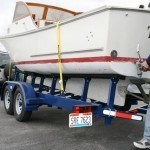
Get A Free Quote

Business Hours
- Monday 8:00 am - 4:30 pm EST
- Tuesday 8:00 am - 4:30 pm EST
- Wednesday 8:00 am - 4:30 pm EST
- Thursday 8:00 am - 4:30 pm EST
- Friday 8:00 am - 4:30 pm EST
- Saturday Closed
- Sunday Closed
Home | About Us | Contact us | Privacy Policy | Blog | Sitemap
Posted 2024-04-08 19:44
Contact Information:
Free drop keel sail boat with sails (Lake hills, Bellevue)

QR Code Link to This Post
post id: 7735467001
posted: 2024-04-08 19:44
♥ best of [ ? ]
refresh the page.
Free drop keel sail boat with sails - boats - by owner - marine sale...
Small drop keel sale boat with trailer. Lost title but I’m looking for it. Picked up this boat a while ago, but I haven’t taken it out in a few years. It’s pretty dirty and has some water in in hull...

IMAGES
VIDEO
COMMENTS
One of the larger boats on this list, the Seaward 26 RK, is still easy to move over land with a trailered weight under 6,000 pounds. The boat alone displaces 3,800 pounds, with 1,200 lbs. of that in retractable ballast with a bulb on the bottom. The keel lifts with an electric motor and is simple to operate.
Let me introduce you to the Trailer Sailer. A trailerable sailboat is in many ways better than a keel boat or a dinghy. You can get a trailer down a boat ramp, it stores for free in your backyard, and it has many of the benefits of a keel boat or dinghy, with fewer drawbacks. Some might argue that the perfect sailboat is the trailer sailer.
Hunter 22. This one has to make the list because it is immensely popular. Rightfully so. It is small enough to be transported on a trailer, plus it has a lifting keel that makes the draft only 30 centimeters when up - but over a meter when down, so it still has to say a lot in terms of performance.
custom sailboat trailers 25′ - 30′ ... beneteau first 285. cape dory 25 d. cape dory 27. capri 25. catalina 25 swing keel. catalina 250 wing keel. catalina 25 wing keel. catalina 27. catalina 28 wing keel. cheoy lee. colgate 26. com-pac 27. contessa 26. falmouth cutter. frisco flyer. gary seal. international dragon. irwin 30.
Whether your keel is a swing, bulb, full, fixed, fin, shoal, wing or retractable, your custom sailboat trailer will be designed to effectively support and protect the keel. Also, properly placed screwpads or treated lumber bunks will support your sailboat's hull and bulkheads. This ensures the safe and sturdy transport of your precious rig!
A trailerable sailboat should weigh less than around 7,000 pounds, as this is the upper towing limit for most typical Class C vehicles. Most trailerable sailboats can be towed behind a typical half ton pickup or SUV. Additionally, most trailerable sailboats have a swing keel or centerboard. This makes it possible to rest a boat on a low trailer.
One of the most popular type of boats was the "trailersailer," relatively light-displacement sloops with centerboards and swing keels, that could be stored in the backyard or driveway, towed behind the family station wagon and launched in about 45 minutes. ... Our preferred solution to the keel/ ballast problem in trailer-sailers is the ...
We combine our modular pods with a keel board and winch stand options on any number of Load Rite or 5 STARR bunk models to conform to many sailboat applications. Each trailer must be specified on an individual basis. To get started, download the attached sailboat trailer specifications document before contacting your local Load Rite dealer.
The boat can handle some serious offshore cruising and features the capabilities of other full-keel sailboats. ... 20 is known to be a truly seaworthy ocean-going sailboat, which happens to be small enough to fit on an average-sized boat trailer. Conclusion.
The deeper the fixed keel, the harder it is for trailering. Should your fixed keel sailboat exceed 25 feet, then you can't trailer it at all. You'd need to keep it in a boatyard and launch it from there. This can be expensive and inconvenient. Weighty boat: Another problem with fixed keel sailboats is the keel adds extra weight to the boat ...
1. carpi 25 Lake Jacomo. Apr 30, 2018. #1. There is a challenge in loading sailboats onto trailers without using a hoist. The angle of the trailer is different than the boat. If the trailer has a stop that the nose fits into it's much higher than the boat while floating then as the boat comes out of the water the bow goes up in relationship to ...
Find A Dealer. You can enjoy the reliability and performance of a Load Rite trailer for your sailboat by specifying a custom trailer through your dealer. We combine our modular pods with a keel board and winch stand options on any number of Load Rite or 5 STARR bunk models to conform to many sailboat applications. Each trailer must be specified ...
7 Best Trailerable Cruising Sailboats. Catalina 22/25 "Pop-Top". Com-Pac Horizon Cat for Classic Coastal Cruising. Marshall Sanderling — Small, Portable, Classy. West Wight Potter 19 — The Tiny Go-Anywhere Sailboat. Seaward 26RK with Retractable Lead Keel. Corsair F-24 Trimaran - Sporty Sailing.
For over 30-years, Triad Trailers has been the industry leader in custom boat trailers. Our custom trailer designs accommodate almost every type of sailboat and boating style since we start every project with custom plans to fit the exact measurement of your boat. If you order a Catalina 25 fin keel sailboat trailer, we build a Catalina 25 fin ...
Shop our selection of shock-absorbing keel trailer rollers from top brands to protect your hull from cuts, abrasions, debris, and more. If you're looking for more boat trailering equipment, check out our pages on: Trailer Rollers, Trailer Jacks, and Trailer Bunks. Enjoy free shipping on all orders over $99 or, for Good Sam members, orders over $69!
The final trailerable sailboat on our list is also the most capable. The Nor'Sea 27 is a true offshore sailboat with accommodations that rival any mid-size cruising sailboat. the Nor'Sea 27 is a full-keel displacement sailboat that's designed for stability and motion comfort. It's one of the beefiest sailboats that still fits on a trailer.
Trailer has a built in guide for directing keel to the center of the trailer for ramp haul outs. Bow support adjustable. Ideal for boats to 28 feet. 2 - 5/16" hitch ball included. Pictured is a 26' boat with 5' draft (boat not included) centered forward on the axles. 28' boat would be centered back 1' and maintain good balance for towing.
5 inch Galvanized Keel Roller Bracket for Boat Trailer. Item Sku: 100161. MPN: N/A. Mounts with 1/2" U Bolts or Bolts to Crossmember. Will Hold 5 inch Keel Rollers. Hot Dipped Galvanized Finish Great for Boat Trailers. 5 inch Galvanized Roller Bracket for Boat Trailer. $17.35 $10.41. In Stock.
We build custom sailboat trailers. Welcome to Custom Sailboat Trailers (281) 844-4458. Custom Sailboat Trailers ... Rubber bushing under keel board to take the shock off the keel. Painted trailer for Catalina 25. J24 ; Hunter 26 ; Oday24 ; $2300 ; 24 ft frame for 30 ft boat for three axles ; This trailer was made for a 5500 lb boat.
The swing keel boat trailer had 14" rims, and the wing keel boat has 15" rims. So you can see the difference in the height pretty easy. We always need to extend out the tongue on the wing keeled boat, but I normally see no extension required on the swing keel boats at regattas. Look at the waterline height at the fenders to really tell the ...
Our full keel powerboat and lobster boat trailers will provide the perfect amount of support whether your boat is 17 or 50 feet in length, and will protect the hull from damage while the trailer is in use. Full keel boat trailers require special consideration to ensure that they meet your needs perfectly. All of our custom trailers come with a ...
propulsion type: sail. condition: fair. length overall (LOA): 18. Small drop keel sale boat with trailer. Lost title but I'm looking for it. Picked up this boat a while ago, but I haven't taken it out in a few years. It's pretty dirty and has some water in in hull that needs to be cleaned. It comes with the trailer, but has a flat tire.